
 Production Reference:
Production Reference:|
|
Translator's Note: Super Robot Generation: Sunrise 1977-1987, volume 34 of Newtype 100% Collection series, is an in-depth retrospective of the robot anime produced in the ten years between the establishment of Nippon Sunrise and the studio's eventual renaming as "Sunrise, Inc." In addition to Mobile Suit Gundam and the sequel series Z Gundam and Gundam ZZ, these include many other landmark works by Gundam director Yoshiyuki Tomino. Published in March 1999, just before the debut of ∀ Gundam, this book includes in-depth interviews with Tomino and some other notable creators, as well as shorter staff comments on specific works and lots of analysis and behind-the-scenes production info. I'll continue adding to this page as I make my way through the book's contents. |
Before a work begins airing, it goes through many twists and turns and situations the ordinary viewer never knows about. Here, as we look back on the history of the robot anime from the Nippon Sunrise era from a comprehensive perspective, we'll also introduce these valuable behind-the-scenes stories and the roots of the works themselves, based on in-depth reporting.
Sunrise's predecessor, Sunrise Studio (Ltd.), was established in September 1972. The works created in this era included Zero Tester (produced with Soeisha), Brave Raideen (produced with Tohoku Shinsha), and Super Electromagnetic Robo Com-Battler V (produced with Toei). (1)
Around this time, Sunrise made contact with Clover, a toymaker that was looking to grow its business by sponsoring a TV anime program. This goal was aligned with that of Sunrise, which had always wanted to launch an original work. In November 1976, the company changed its name to Nippon Sunrise (Inc.) and began working on an original plan. This became Super Machine Zambot 3, which began airing in October 1977.
Zambot was well-received in terms of both audience ratings and toy sales, and after a three-month blank following the end of the series, The Unchallengeable Daitarn 3 began airing in June 1978. Because the audience might get bored with the serious approach of the previous work, Daitarn switched to a comedy approach and earned a favorable reception.
With the success of these two works, and the tailwind of the anime boom which was then reaching its peak, Sunrise began planning "a taiga drama-style anime aimed at late teens." This plan became Mobile Suit Gundam, which began airing in April 1979 and turned into a hit series that still continues to this day.

1977 Super Machine Zambot 3
• A giant battery-operated toy standing 44 cm tall. With the hit success of Zambot and Daitarn, Clover became a major toymaker overnight.
1979 Mobile Suit Gundam
• At the start of planning, the concept was that the Zaku would be the only type of enemy robot, as represented by this shot from the opening.
• A comic published by Akita Shoten (by Yu Okazaki). This is a collection of the story serialized in "Adventure King" during the broadcast. Yu Okazaki also did a Daitarn 3 serial in the same magazine.
• "How to Build Gundam," published by Hobby Japan. As a groundbreaking mook devoted only to Gunpla customization techniques and dioramas, this drew much attention at the time.
Though Gundam became a major hit, its toy sales were sluggish during its broadcast run, so it was decided that the next work would be created "purely for children." This was The Unchallengeable Trider G7, which began airing in February 1980. The protagonist's image would be that of a lively and mischievous boy, which was rare in the anime of the time. From there, the work went in the direction of a "working-class humanity story." (2)
Meanwhile, Sunrise received a request from the toymaker Tomy, which had sponsored the 1979 Sunrise-produced anime Science Adventure Command Tansar 5. Tomy wanted to create a robot anime which made use of the one-touch transformation feature that was so popular in Tansar 5, while adding a robot combination. Thus the planning of Space Runaway Ideon began. Ideon began airing in May 1980, and though its toy sales were disappointing, it evolved into a masterpiece whose content ventured into the realm of philosophy, and which had a great influence on the later anime scene.
Since the previous Trider G7 had been successful in terms of both toy sales and audience ratings, it was decided that the followup work would also target a younger audience. Robot King Daioja, which began airing in January 1981, was an orthodox robot anime in which good was rewarded and evil punished, incorporating the flavor of Mito Kōmon. (3)

1980 The Unchallengeable Trider G7
• An encyclopedia published by Kodansha. In addition to a cover illustration by Kunio Okawara, it was packed with mecha, character, and story information, as well as original illustrations by Yutaka Izubuchi.
1980 Space Runaway Ideon
• A deluxe toy released by Tomy. Though its combining gimmick was superb, the impression it gave was very far from the image of the TV version.
• "Space Runaway Ideon & The World of Yoshiyuki Tomino," a mook published by Kodansha. Before this, there had never been a mook named after an anime director.
• The Ideon using the wave motion gun introduced in the middle of the program. This weapon, which generated mini black holes, was the most powerful in anime history.
Fang of the Sun Dougram began airing in October 1981. It was launched because Gundam and Ideon had demonstrated that robot anime could also be targeted at late teens. Since the work's narrative was realistic, so was the mecha, and gimmicks such as transformation and combination were eliminated from the main robot.
In February 1982, Blue Gale Xabungle began as a followup program to Daioja. Because toys of the three combining robots from Daioja hadn't sold well, this plan returned to the approach of "each mecha transforms and then they combine into a robot." However, because the robot itself had been designed ahead of time, there was too large a gap between it and the worldview of the work itself. Thus the Walker Galliar, the first replacement robot in anime history, was introduced in mid-story. With this program, the toymaker Bandai also began releasing plastic models in a form that didn't conflict with Clover's toys.
The following year, in February 1983, Aura Battler Dunbine started in the same time slot. This incorporated elements of heroic fantasy, and its insect-themed robots also gained popularity. In August of that year, the main sponsor Clover went bankrupt. The production thus had to deal with an unprecedented situation, and the broadcast run ended with 49 episodes instead of the planned 50.

1981 Fang of the Sun Dougram
• The Dougram was the first faceless robot in anime history. Though the realistic mecha setting was a selling point, the dramatization often depicted it like a hero robot.
• The Dual Models, hybrid toys made from plastic and die-cast metal, were a big hit. The internal mechanisms were also reproduced in precise detail.
1982 Blue Gale Xabungle
• Viewers were surprised when other robots of the same type as the main robot Xabungle appeared from the very first episode.
• A deluxe toy of the replacement robot, the Walker Galliar, released by Clover. All its joints were movable, and it separated and transformed just as in the setting.
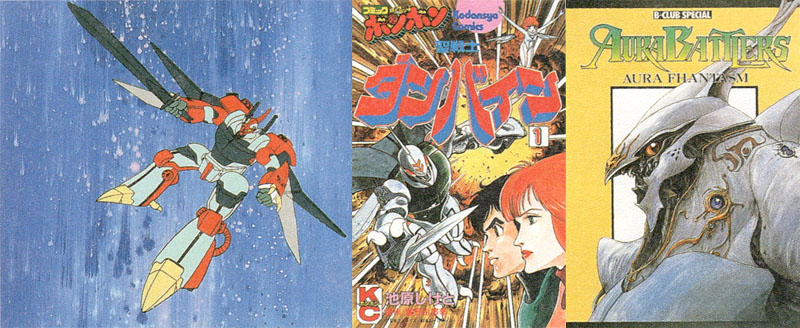
1983 Aura Battler Dunbine
• The Billbine was introduced in the second half of the program. Its name was a combination of "Dunbine" and "Build," as in "make a new robot."
• A comic version published by Kodansha (by Shigeto Ikehara). Though it was serialized in a children's magazine at the time of broadcast, it had hard content that depicted the TV story relatively faithfully.
• A mook published by Bandai. Focused exclusively on the aura battlers, it included valuable material such as early setting and original aura battlers.
Armored Trooper Votoms began airing in April 1983, around the same time as Dunbine, as a followup program to the long-running Dougram. The military aspects were emphasized even more than in Dougram, and the realistic design thoroughly eliminated all heroic elements from the main robot. At the same time, the core narrative itself had a strong fantasy element in the form of Wiseman, an entity that transcended humanity. This was also Sunrise's first attempt to use a title that didn't include the name of the main robot.
The broadcast of Round Vernian Vifam began in October 1983. With a typical anime, the plan would be launched a year before it aired, but with Vifam this was an unusually short period of 8 months. It's also noteworthy that this work revived the original plan for Gundam, which was a space version of Two Years' Vacation. From this point on, the focus of the merchandising changed from traditional die-cast toys to plastic models and realistic toys made from shock-resistant ABS resin.
Heavy Metal L-Gaim began airing in January 1984 as a successor to Dunbine. Responding to the demands of fans who had begun to emphasize the mecha setting, the robot designs incorporated new and unprecedented ideas such as the use of rubber in their fingers.

1983 Armored Trooper Votoms
• The military aspects, such as the fact that various optional weapons could be attached to the basic Scopedog, also increased its popularity.
• A picture book published by Kodansha, with content designed for younger readers. It's interesting that, in contrast to the hard content, it kept to the picture book format and included catchphrases such as "Let's all sing it together" in reference to the theme song.
• Toys released as part of the second round of Dual Models after Dougram. The landing pose, arm punch, and other gimmicks were reproduced quite faithfully.

1983 Round Vernian Vifam
• As a main mecha, the robot had few heroic traits. But as the story itself grew in popularity, sales of the plastic models increased as well.
1984 Heavy Metal L-Gaim
• A deluxe toy released by Bandai. It attracted attention with mobility and balance not seen in traditional alloys, which enabled it to stand on one leg.
Yoshikazu Yasuhiko, who had become an overnight celebrity with his character designs for Gundam, brought a plan to Sunrise which began airing in April 1984 as Giant Gorg. While the robot animation of the time focused on realistic approaches, this one developed into a straightforward adventure story aimed at young boys, and it was a high-quality work in which Yasuhiko applied his personal touch to the animation as well.
Panzer World Galient started in October 1984. The world of the story, which incorporated a Western flavor not seen in previous Sunrise works, anticipated the "sword and sorcery" boom centered on video games that began in 1986. Perhaps it was a masterpiece that came ahead of its time. Like Votoms, it was sponsored by Takara, but because the Votoms toy merchandising had fared poorly, the main robot in this work included gimmicks like transformation and combination.
Super Robot Galatt, Sunrise's first gag robot show, began airing in the Tokyo region on the same day as Galient. The selling point was that the main robots changed from two-head-tall deformed types, which were starting to become popular at the time, into hero types. This was also the work that introduced the "morphing" element to the robot genre. (4)

1984 Giant Gorg
• The touch of the original creator Yoshikazu Yashiko was foregrounded not only in the work's story, but in the onscreen layout and animation as well.
1984 Panzer World Galient
• The unique world setting had a medieval European motif. The robots that appeared were excavated from beneath the ruins of an ancient civilization.
Mobile Suit Z Gundam, the sequel to Mobile Suit Gundam, began airing in March 1985. The plan was proposed from the Bandai side because, in short, Bandai had run out of material for the mobile suits it was releasing as plastic models.
The setting within the program for the main mecha, the Gundam Mk-II, was that it was a successor to the first Gundam. But in design terms, it was based on the concept of what the first Gundam, which retained many elements of hero robots, would be like if it were refined in 1985. The true main mecha, the Zeta Gundam, was meant from the beginning to appear in the latter half of the program. This was partly because it was a mobile suit with a new concept whose design and product development required more time.
Next, Blue Comet SPT Layzner started in October 1985. Reflecting an era which preferred rectilinear mecha, the main mecha had sharp design lines. The innovative head was inspired by the cockpits of fighter aircraft, making this a design partway between hero robots and real robots.
Around this time, Sunrise also began entering the field of video media in earnest, with continuations of works such as Votoms and Vifam that had been popular on television.

1985 Mobile Suit Z Gundam
• A mook published by Kadokawa Shoten. In addition to the mechanical edition shown here, there was also a character edition. These were all republished in 1998, and are still available.
• A novel version published by Kodansha. This was a novelization by Director Tomino, with cover illustrations by Mamoru Nagano. Depicting Char and the mobile suits with an approach different from the TV version, these were very appealing.
• A plastic model released by Bandai. The transformation gimmick was featured on the packaging, making a selling point of the fact that this was the first transforming mobile suit and that the product also transformed perfectly.
In March 1986, Mobile Suit Gundam ZZ began airing as a followup program to the well-received Z Gundam. The ZZ Gundam was given a heavyweight design to contrast with the sharp impression of the Zeta Gundam. In order to explain the Gundam world to younger fans, a special program called "Prelude ZZ" was broadcast as the first episode. This was also done to buy time for production, since the decision to air ZZ had been made so late.
After this, Metal Armor Dragonar started in February 1987. Its simple forms, inspired by the first Gundam, were an antithesis to the mecha designs of robot anime which had become overly complicated.
In April 1987, during the broadcast of Dragonar, the company name was changed to Sunrise (Inc.). In the 1990s, it went on to create new robot shows such as the "Brave" and "Eldran" series.
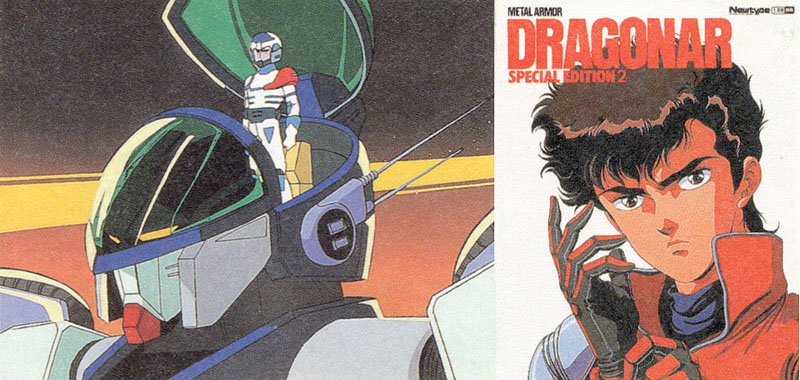
1985 Blue Comet SPT Layzner
• The "Layzner" title evoked the image of optical weapons such as lasers and rayguns, and the logo design was also very sharp.
1987 Metal Armor Dragonar
• A mook published by Kadokawa Shoten. It included detailed specs for the metal armors and other mecha, as well as story and character information.
(1) Following 1976's Com-Battler V, Sunrise went on to produce several other robot anime series for Toei—1977's Voltes V, 1978's Daimos, and 1979's Daltanious. Mecha designer Yutaka Izubuchi, who created enemy robots for Daimos and Daltanious, went on to play the same role on Sunrise's own Trider G7 and Daioja.
(2) The Japanese phrase 下町人情 (shitamachi ninjō), literally something like "downtown human sentiments," apparently means "the compassionate feelings of middle- and lower-class people."
(3) Mito Kōmon was a long-running period drama in which a wandering hero dispenses justice. "Daijoa" was essentially a science fiction version of this premise.
(4) The term used here, 変身 (henshin), means "metamorphosis" or "shapeshifting." It's commonly used in connection to superheroes and live-action special effects shows such as Kamen Rider and the Super Sentai (Power Rangers) series.
Translator's Note: Although this section of the book is filled with mecha setting art and commentary, I've focused here on translating the parts that provide critical analysis or behind-the-scenes production info, rather than simply describing the mecha and the onscreen story.
Story • The Gaizok have come from outer space to destroy the Earth. In this time of crisis, the Jin family, the descendants of aliens who once fled to Earth when their homeland was destroyed by the Gaizok, rise up with the spaceship King Bial and the giant robot Zambot 3. But as the people caught up in the conflict turn their anger against the Jin family rather than the Gaizok, the Jin family are forced to fight a lonely battle...
Commentary • As the studio's first original work, it focused on aspects that traditional robot anime had overlooked. Politicians and people fleeing during battles with the enemy were depicted onscreen in a naturalistic way. Through its portrayal of the Jin family, this unique work also questioned the bonds between family members, their respective roles, and the nature of justice. It aired at 5:30 PM Saturdays on the Nagoya Broadcasting Network, and ran from October 8, 1977, to March 25, 1978. 23 episodes total.
Staff •
Cast •

Zambot 3: A version cleaned up by Yoshikazu Yasuhiko. The design has a fairly large number of lines for a robot of its time. It's distinguished by an overall design based Japanese armor and samurai, with a crescent moon-shaped decoration on its head and protruding shoulders. Its armament is also unified by this concept.
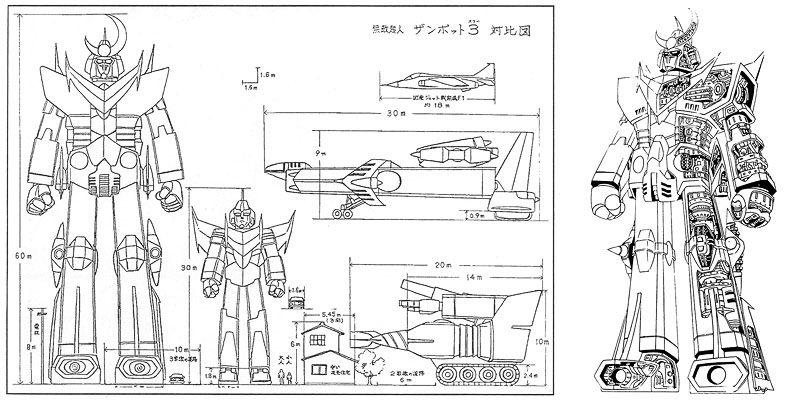
Internal cutaway: Sunrise's materials say this was drawn by Studio Nue, and in his interview at the end of this book Okawara himself says he didn't touch it this design, but it's also been said that this was created by Kunio Okawara and the details are unclear.
Comparison diagram: The main mecha and fighter aircraft compared to people and buildings. We can see how huge all the Zambot mecha are.
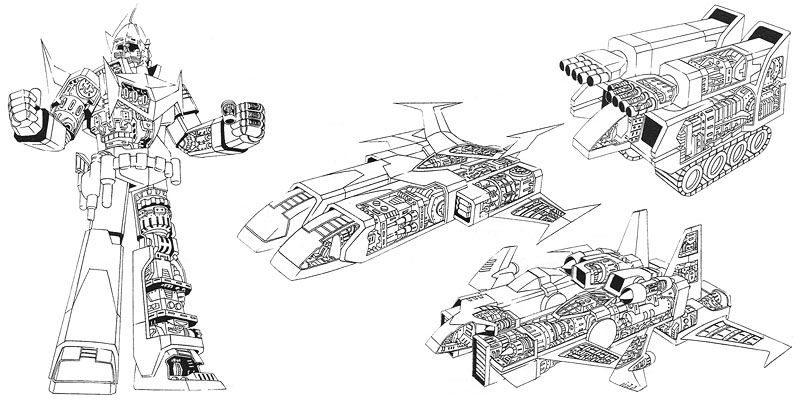
Zambot mecha internal cutaways: This internal cutaway setting for each of the Zambot mecha was apparently drawn for magazine publication. The internal cutaways for the Zambo-Ace and Zambird, which are the same machine, were drawn with a consistent internal structure and take the storage gimmicks of the limbs into account. Likewise, the interiors of the Zambull and Zambase were carefully drawn so as not to contradict the internal cutaway of the Zambot 3.
In Zambot's planning meeting stage, a five-part combination was also proposed for the main robot, but planning proceeded with a three-part combination due to issues such as the sponsor's funds and technical capabilities, and to save labor in terms of setting and animation.
Yoshikazu Yasuhiko, who was responsible for character design, was very busy at the time. Thus he did only the characters and revisions to the main mecha, and wasn't directly involved with the animation of the actual show.
The broadcast itself ended after half a year, just as originally planned. But the audience ratings and toy sales were both favorable, so episode 22, "Eve of the Decisive Battle," was hastily produced as an extra insert episode. The animation was done by the staff of the followup program The Unchallengeable Daitarn 3.
As for the music, this was the first time Takeo Watanabe, who had previously worked on sports anime like Star of the Giants, World Masterpiece Theater anime, dramas, jidaigeki, and so forth, had ever been responsible for a robot anime. (1) His compositions filled with lyricism gave the story even greater depth.
The title "Zambot 3" combined the ideas of "three mecha that form a robot" and "Sunrise's robot."
At the time of Zambot 3, Sunrise had only just become a joint-stock company, and it was difficult because we had such a small staff.
I was the one who gave it the title "Super Machine Zambot 3." I chose "Super Machine" with the feeling that the protagonist's Jin family, as extraterrestrials, were supermen rather than ordinary humans. (2) Titles like "Invincible Robot" and "Mightiest Robot" were also suggested, but I figured we'd use those later on when we ran out of name ideas. (laughs)
We'd asked Mr. Ryoji Fujiwara to design the robot, but we also asked Mr. Yoshikazu Yasuhiko to clean it up so it would look cool when it moved in the animation. Mr. Yasuhiko had worked with Sunrise on things like Brave Raideen, so he already had a reputation for skillfulness.
The protagonist Kappei was established as being in the first year of middle school, but we made him shorter so that he'd be more relatable for an audience of children. Uchuta and Keiko have heights more appropriate for their ages.
On the cover of the proposal, the title of the work is written as "Zambot 3" without a subtitle, but inside the proposal it's written "Invincible Zambot." In this proposal, the mecha corresponding to the Zambo-Ace is tentatively named the "Sumo-Zambo," and the Zambase is the "Zamborg." The protagonist Kappei Jin is named "Amaoka Jin," and the other characters all share the same "Jin" family name.
The storyline described in the proposal is almost identical to the broadcast version, but there's also the idea of depicting discord within the Jin family as some of its members, afraid of battle, plan to escape from Earth.
Aside from this proposal, there's also another one by director Yoshiyuki Tomino. (3) In addition to a series structure plan for all 25 episodes, the character Shingo Kozuki is also mentioned here. (4) The main robot is tentatively named "Zambot Moon," and the enemy mecha are called "Mecha-Beetles" rather than Mecha-Boosts.
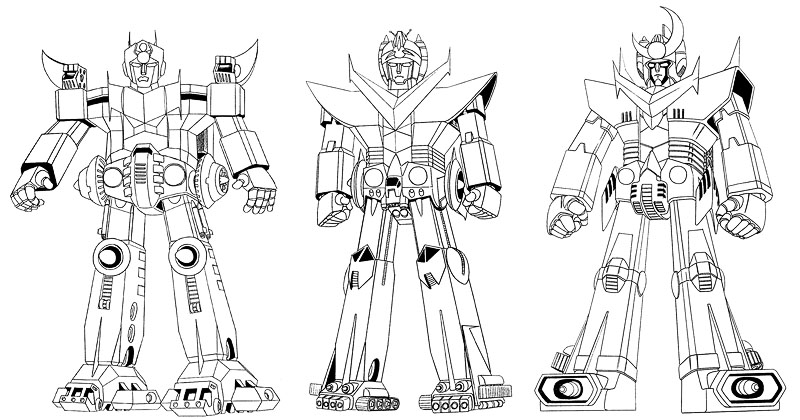
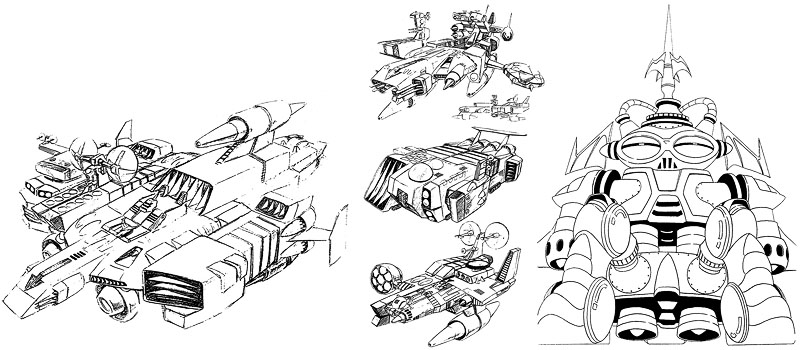
King Bial early design: This was drawn by Studio Nue, who were credited with design cooperation. The overall silhouette is identical to the final version, but the details and the transformation and combination gimmicks are very different.
Bandock early design: A rough draft of the enemy base Bandock, drawn by Kunio Okawara. Like the Zambot 3, it is designed to separate into three parts—head, torso, and legs.
Story • Banjo Haran rises up in the Daitarn 3 to crush the ambitions of the Meganoids, a gang of space cyborgs based on the planet Mars who plan to reconstruct and rule over all of humanity. Banjo calls for justice "for the world and for the people," but in fact his battle is also a form of revenge against his father, who developed the Meganoids and sacrificed the lives of his family...
Commentary • A work distinguished by its unique characters, such as a protagonist who began with the idea of "though he's a hero, he's not a hero inside or out," and who looks cheerful at first glance but would abandon his comrades in order to win; the Meganoid Koros, who believes humans can't live in peace without being controlled; and Garrison Tokida, who is aloof but regards battle very seriously. Amid the light dialogue with its comedic touch, we can catch glimpses of the passions and karma with which humans are burdened, adding depth to the story and creating a sense of mystery. It aired at 5:30 PM Saturdays on the Nagoya Broadcasting Network, starting June 3, 1978. 40 episodes total.
Staff •
Cast •

Daitarn 3: The decoration on the head is designed to resemble the helmets of Japanese armor. This was the third Sunrise-related giant robot with a mouth after Brave Raideen and Fighting General Daimos.

Internal cutaway: Internal cutaway diagrams by Kunio Okawara. It appears these were drawn for publication in magazines aimed at children. They were carefully drawn so that the internal structures are consistent in every form.
So as not to bore the audience, this work made a complete turnabout from its serious predecessor Zambot 3 and used a more comedic touch. Since the concept was a robot anime version of the British "007" movie series, the protagonist Banjo Haran was established as a young man, and two heroines who resembled Bond girls were included as well.
The rough character designs were drawn by Hitokazu Kokuni (a pen name for Tomonori Kogawa, later responsible for Space Runaway Ideon), and Kokuni also completed the enemy characters, while Banjo and his comrades were cleaned up for animation by Norio Shioyama. As for the mecha design, the main robot was a transforming type to differentiate it from the combining one in the previous work. The broadcast run was also extended to three cours.
This was the first time I was able to work with Sunrise in earnest. The planning of Daitarn 3 actually began before Zambot 3, but the sponsor went bankrupt, so it was temporarily put on hold. (7) It was later decided that Daitarn 3 would be the second Sunrise work.
The idea of one robot with a three-stage transformation was proposed by Mr. Eiji Yamaura, the head of the Sunrise planning department at the time. We quickly agreed that the tank form could provide power, and the aircraft form quick movement. In designing it, I remember being careful not to duplicate robots like Toei's Super Electromagnetic Machine Voltes V.
The title in the proposal is "Invincible Robo Daitarn 3," and though it's not clearly stated in the show itself, the chronological setting is established as 1988, about ten years after the broadcast. (5) In this proposal, the Mach Attacker is called the Protect Car, and when the Daitarn 3 transforms, it's called the Daitarn Fighter and Daitarn Tank. (6)
The names "Daitarn 3" and "Banjo Haran" were chosen by Director Tomino. Incidentally, Director Tomino is very fond of Banjo Haran, and he later published several novels about the character with a slightly altered setting. The mecha design was based on Japanese armor, which is particularly apparent in the heads of the two early designs on the left.
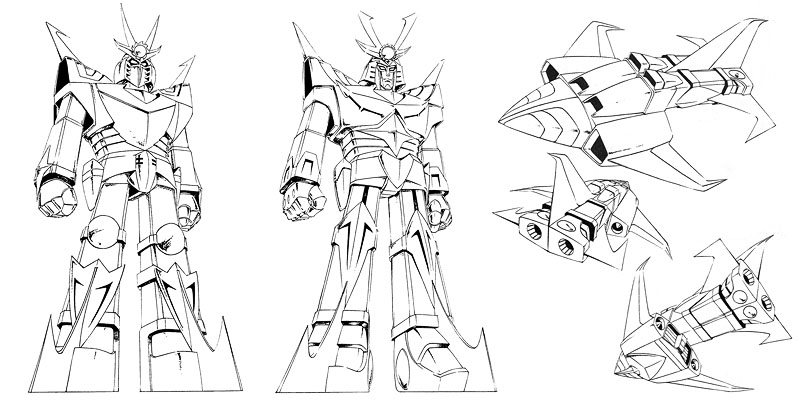
Story • In the year Universal Century 0079, the space colonies of the Principality of Zeon have declared their independence and begun an invasion of the Earth Federation. To oppose the Zeon forces, which have gained the upper hand in the war by deploying their new mobile suit weapons, the Federation Forces develop mobile suits of their own. A boy named Amuro Ray accidentally boards the prototype mobile suit Gundam, and together with the boys and girls fleeing the Zeon forces aboard the space carrier White Base, he is caught up in the maelstrom of war.
Commentary • It goes without saying that this is a monumental landmark of giant robot anime. Yoshiyuki Tomino, Yoshikazu Yasuhiko, Kunio Okawara, and other stellar talents came together to give birth to a realistic SF drama that defied all previous conventional wisdom. Its audience ratings failed to grow during its broadcast run, and it ended with episode 43, but it became a huge hit with the ardent support of anime fans and the success of the plastic models. Countless sequels and new works were created afterwards, and its popularity continues to this day. It aired from 5:30 to 6:00 PM Saturdays on the Nagoya Broadcasting Network. 43 episodes total. The broadcast ran from April 7, 1979, to January 26, 1980.
Staff • Planning /
Cast •

The "mobile suit," which positioned the giant robot as a futuristic weapon, was derived from the powered suits that appear in R.A. Heinlein's novel Starship Troopers. In the earliest proposal plan, "Space Combat Team Gunboy" (tentative title, Nagoya TV Programming Department), these were powered suits referred to as giant mobile infantry, but by the time of "Mobile Steel Man Gunvoy" (tentative title, Sotsu Agency) they had become "mobile suits," and the setting used in the broadcast version had more or less taken shape.
Thanks to detailed setting such as Minovsky particles that disrupt radio waves, and attitude control using the movement of mass in outer space, a world was painstakingly constructed in which "it's not unreasonable for giant robots to engage in visual-range combat." Fans were fascinated by the realism this created. Of course, we also shouldn't forget the appeal of the characters, who were filled with the same kind of realism.
The Gundam's design was initially something like a diving suit. The idea came from Starship Troopers, so even though it was a giant robot, it still had the image of a powered suit. Thus I wondered whether I could make a robot that wasn't just a combination of blocks and cylinders, like the previous Zambot and Daitarn, and I believe that's why I gave it calves. It also reflected the ideas of many other people, and finally Mr. (Yoshikazu) Yasuhiko put it all together according to his own taste. I think that's why it ended up having such a cool, great-looking silhouette that's still easy to draw.
The details of the Gundam's face may be troublesome, but it's pretty easy to get the shape. There hadn't really been a face like that before, though, so it may have been hard for the animators to draw. Even I had trouble with it. It's full of pitfalls. (laughs) It doesn't have a mouth because it's better not to have one in a robot show for grown-ups.
The Gundam's design began with a realistic approach unprecedented in anime robots, attempting to break away from previous robot designs. Here, we will introduce some of the unique designs produced along the way.

Gundam: A "Gundam with a mouth" was also designed, in the tradition of the Daitarn. In the image at left, it's carrying a spray gun. At center is fully equipped Gundam designed for the toy version. The equipment is completely original.
Guntank: A Guntank with hands instead of missile launchers. It also has machine guns in the turret section.
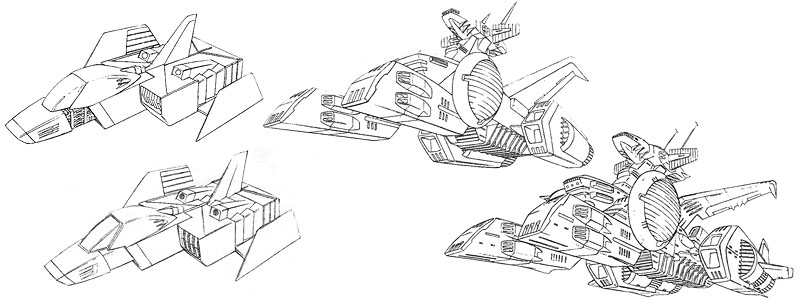
Core Fighter: A fairly crude Core Fighter compared to the final version. After being refined as per the image on the right, it was finally cleaned up by Yoshikazu Yasuhiko.
White Base: An early design for the space carrier White Base. This mecha was actually conceived during Daitarn 3, and it's inspired by the Sphinx.
Story • The Robot Empire, which plans to subjugate humanity, sends a succession of giant robots to attack Earth. Watta Takeo, a grade-school student who is also the president of an all-purpose space business called the Takeo General Company, battles this mysterious enemy using the giant robot Trider G7 that was left to him by his father.
Commentary • Incorporating elements of domestic situation comedy, this pioneered a new genre which could be called working-class robot anime. (8) It was an ambitious work that included some experimental elements, such as the fact that the story ends without the protagonist's side ever learning the enemy's true identity. The scenes of the robot launching from a public park also made a lasting impression. This was the first time Katsutoshi Sasaki, who had served as an assistant director under the late Tadao Nagahama, set out to direct a series, and it earned consistently high audience ratings. (9) It aired at 5:30 PM Saturdays on the Nagoya Broadcasting Network, starting February 2, 1980. 50 episodes total.
Staff •
Cast •

Trider G7: The Trider G7's hangar is underneath a public park. Part of its head protrudes into the park, and is normally part of a children's playground, but the park is designed to split in two during launch so that the Trider can take off. This unprecedented launch sequence, accompanied by the announcement "The Trider is now launching," also drew much attention.
The Tomino series airing on Nagoya TV, which had continued for three works starting with Zambot 3, came to a temporary end with Gundam, and The Unchallengeable Trider G7 was launched as a robot show aimed from the beginning at children. The reason for this change of direction was that the more serious Gundam had struggled both in terms of audience ratings and merchandising.
New mecha to power up the main robot appeared in the second half of the program, probably due to the popularity of Gundam's G-Armor. Such power-up mecha are taken for granted nowadays, but at the time, introducing new mecha tied so closely to the toys was still an unusual idea.
As for the design, the appointment of multiple character and mecha designers also succeeded in expanding the range of the visuals. In particular, the enemy mecha created by Yutaka Izubuchi, who was still a newcomer at the time, were beloved by fans who nicknamed them "Buchi-mecha."
This was another work for which I created a carved wooden mockup for presentation purposes. Since it had a transformation gimmick, I was also concerned about its strength when it was turned into a toy. Back then, unless you had something like that, sponsors often couldn't understand how it functioned.
Mr. Yutaka Izubuchi was in charge of the enemy robots, but I did pretty much everything on the main robot and its power-up parts. That was still an era where the standard was to have only one designer for a single work, so it was pretty tough. (laughs)
I'm sometimes asked whether the head design was meant to have a bird motif, but I went through a lot of trial and error as I tried to express the robot's heroic nature, and I only completed it after drawing many different variations.
In the early planning stages, I think the content was something like "A 22-year-old company president goes into space in his robot and fights gangs." We were thinking of something like Yujiro Ishihara's movies. (10) But we felt it would be better if the audience and the protagonist were closer in age, so we made him a grade-schooler.
At that time, actors who gave an impression of familiarity were starting to become more popular than handsome men and beautiful women, so rather than a superhero, we wanted the protagonist to be a straightforward boy who was bad at studying but had a kind heart. Thus we boldly decided on the setting of a grade-school student who was also a company president.
Once we'd come up with this image for the protagonist, we went in the direction of creating a working-class family drama. It was a work that got high audience ratings, and the toys sold well, too.
The Trider's transformations included the basic robot form, three forms of the head, and three forms of the main body, for a total of seven types. These seven transformations were an idea proposed by Sunrise. "Trider" was chosen as the name of the main robot, with the meaning "We'll try anything." But that didn't really work on its own, so they added "G7."
First the numeral "7" was appended because it transformed into seven types, and then the letter "G," which was not only the seventh letter of the alphabet but also had meanings like "great," "giant," and "ganbare." (11) This gave us the current title.
The protagonist's name "Watta Takeo" came, of course, from "a straightforward personality." (12)

Emblem Collection: Along with the helmet on the head, the emblem on the chest is a part of the robot that's important for creating an impression the viewer. Thus many patterns were considered for the emblem, including stylized birds and letters as well as mechanical parts, as shown in these images.
Story • The time is the future. On the planet Solo, to which humanity has just begun to emigrate, a spaceship and a huge humanoid robot are unearthed. Due to a misunderstanding over the limitless power hidden within this robot known as the Ideon, the Earth people find themselves at war with the alien Buff Clan, and they begin a desperate flight for survival as they escape to the Milky Way galaxy...
Commentary • The most unique of works, which depicts the main robot as "a tool that humans can't control" and pessimistically shows people losing their lives at the mercy of this "tool." As well as human relationships that expose their deepest egos, it was famous for its action scenes filled with epic battles and wildly dancing missiles. It aired at 6:45 PM Thursdays on the Tokyo Channel 12 Network (changing to 7:30 PM Fridays as of episode 22), starting May 8, 1980. 40 episodes total. Theatrical film versions were also released in July 1982.
Staff •
Cast •
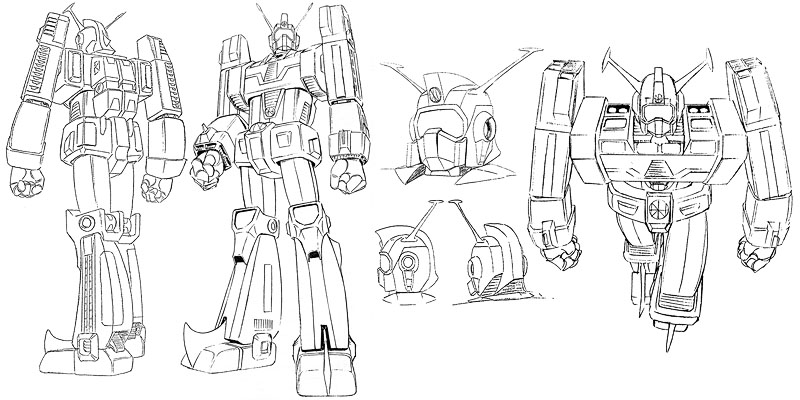
Ideon: The mecha design was by Submarine, but their work was cleaned up for the anime by animation director Tomonori Kogawa.
Head: The Ide mark on the forehead was added at Director Tomino's request.
Right: A drawing by Tomonori Kogawa. This impressive pose was depicted in the opening film as well.

Orthographic views: Orthographic views that emphasize the combination. These were made with a focus on functional aspects such as the alignment of all the parts during transformation and combination, rather than on looking cool as drawings.
Cross-section diagram: A setting illustration showing the positional relationship between the cockpits of each machine after they combine to form the Ideon. Vehicles called Moviolas allow movement between the cockpits.
This work began with a request from the toymaker Tomy to create a new robot anime. Though the completed toys themselves were complex and sophisticated, the content of the work was so philosophical that it couldn't capture the young audience that was the original target. It struggled in the audience ratings and ended up being canceled, with the originally planned one-year broadcast run cut off at three cours.
However, during the broadcast, a strange excitement began to grow among some of the fans. Thanks to the momentum of the ongoing anime boom, the canceled part of the story was finally released as a theatrical movie.
Though this work is often discused in terms of its challenging content, it was also remarkable as an action anime, and we have yet to see an anime surpassing the scale of this "chase drama with a vast galaxy as its stage."
I began designing a combining robot at the request of Mr. Eiji Yamaura, who was the head of the Sunrise planning department at the time. I think the initial concept was that a school bus, an armored car, and a tanker truck would each transform into aircraft, and then combine to form a robot.
The protruding shoulders weren't intended to make the silhouette more interesting, it's just that there was no other choice given the transformation mechanism. (laughs) That's what happened when we physically combined the three mecha, and the silhouette came after the fact.
Anyway, I had my hands full just thinking about things like the transformation structure. I honestly still regret that I couldn't give proper attention to the color scheme and relief decorations of the body itself. I've done various anime designs, but Ideon is the only one I still get interviewed about like this.
In the planning stages, this work had tentative titles such as "Space Runaway Gandorowa," "Space Combiner Ideon," and "Liner Space Ideon." The Soloship was originally given the name "Mayflower" after the 17th-century migrant ship that carried the Puritans from England to the American continent, but this was changed due to trademark issues.
As for the protagonist Yuki Cosmo, he was named "Yuki Shin" when Tomonori Kogawa drew his first rough draft. Two versions were drawn, with and without the Afro hairstyle.
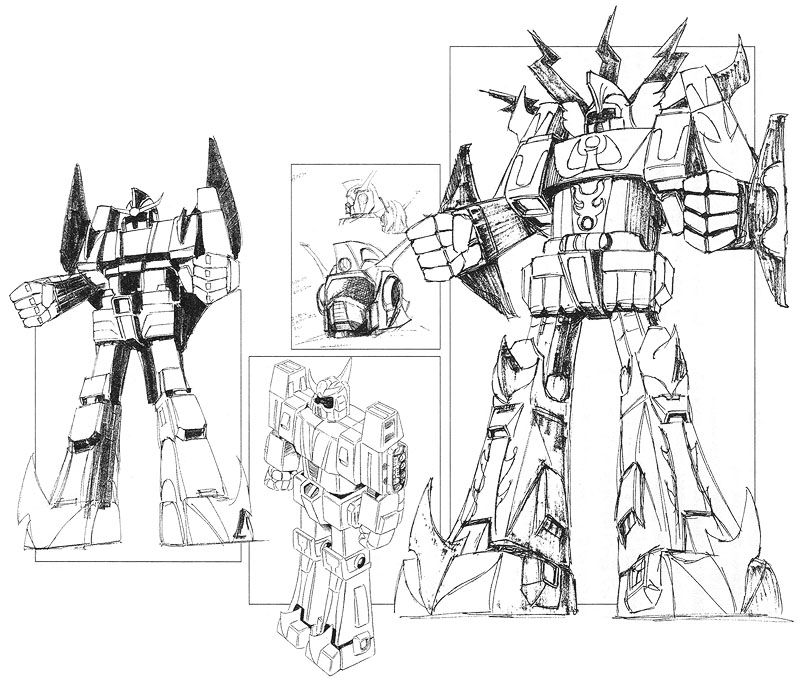
Left: It seems the idea of storing the head inside the shoulder parts was decided at a very early stage.
Center: An early head design. The expressionless goggle-type face was suggested by Director Tomino.
Right: A distinctive design with lightning-bolt decorations on its back. Its body is covered with stylized flame reliefs.
(1) Jidaigeki (時代劇) is a genre of historical drama, typically in live-action film and television, set before the Meiji restoration.
(2) The Japanese subtitle 無敵超人 (muteki chōjin) literally means "Invincible Superman."
(3) Presumably the earlier proposal was by scriptwriter Yoshitake Suzuki, who is credited with the original story.
(4) Shingo Kozuki is a supporting character, voiced by the same actor as Gundam's Kai Shiden, who starts out as a rival to the protagonist Kappei and blames the heroes for the destruction caused by the ongoing battles. One might say he's very much a trademark Tomino character type.
(5) The final subtitle 無敵鋼人 (muteki kōjin) literally means "Invincible Steel Man."
(6) In the animation, the Daitarn 3's transformed modes are called the "Dai-Fighter" and "Dai-Tank."
(7) This original sponsor was apparently the toy company Bullmark, which went bankrupt in late 1977.
(8) The Japanese term used here is 下町人情 (shitamachi ninjō), which I phrased above as "working-class humanity."
(9) Tadao Nagahama was a legendary robot show director, who took over from Yoshiyuki Tomino on Brave Raideen and went on to direct the so-called "Robot Romance" trilogy of Com-Battler V, Voltes V, and Daimos. He died unexpectedly in November 1980, at the age of 48.
(10) The actor Yujiro Ishihara became famous as a young leading man in Nikkatsu's live-action movies.
(11) Ganbare (頑張れ) is a phrase of support and encouragement.
(12) The Japanese expression 竹を割った (take wo watta), which literally means "splitting bamboo," indicates someone frank and refreshingly straightforward.
(13) The Japanese text here credits Yatate and Tomino with "original plan," but I've revised this in my English translation to match the actual TV credits.
(14) The Japanese text here credits Submarine with "mecha design cooperation," but I've revised this in my English translation to match the actual TV credits.
Success, failure, and then revival. Director Tomino says "I'd like the youngsters to know my history over the last twenty years and use it as a textbook." It's a passionate message for those who must live through the turbulent end of the 20th century, and then into the new one!
PROFILE
After serving as series director for the first time on the 1974 TV anime Triton of the Sea, he's worked mainly on Sunrise works. In particular, he became famous for 1979's epochal robot anime Mobile Suit Gundam, and he is attempting to create a new Gundam in 1999.
I didn't touch it at all. That was decided by the sponsor and Sunrise, and the title "Zambot 3" had already been decided by the time I came on board. But with the following Daitarn 3, it was after I joined, and I think it was settled by me saying something like "I think Daitarn 3 is fine."
Of course. As far as the title, I just thought it would be fine to go with something straightforward, without thinking too much about it.
I did both Zambot and Daitarn, but the credit went to the Sunrise planning office. So with Gundam, I started using the "Rin Iogi" pen name. Unless a company recognizes individual artists and individual independence, the company itself won't survive. So I used a pen name, because saying it was the Sunrise planning office created the misconception that the entire organization created it.
As for Gundam, we initially tried to go with the title "Gunboy," but when we checked the trademark we couldn't get it. So eventually we decided on "Gundam." However, "Gundam" is actually also trademarked in a field unrelated to film or publishing, so we added the subtitle "Kidō Senshi."
I started working on the novels before the TV version of Gundam itself became a hit. Mr. Haruka Takachiho was the intermediary who introduced me to Asahi Sonorama. Anyway, I started on it wondering "Could you make a novel out of a robot show?" The first volume was published by the time the show went off the air. Then it became a breakthrough hit, so I wrote a second and third volume as well. (laughs)
Basically, the novel version is close to the story I'd wanted to tell. That's why the contents diverge from the TV version. At first, the idea of turning a robot show into a novel was completely ridiculous back then.
Maybe in hindsight, but I have no idea. Ten or fifteen years later, staffers who read them came into the workplace and called me all sorts of bad names, saying "The content is different from the TV version!" (laughs) When people ask me "Why did Amuro die?" it's because otherwise I couldn't have turned it into a novel back then. Since robot anime was dismissed as not being science fiction, I was trying my best to explain the mobile suits and make them seem more science-fictional, so that it would be at least a little closer to SF. (laughs)
That's because I liked Banjo. I was wondering whether I could create another work with him, and since anime novels were now recognized as a genre, they were also easy for me to write. But I regret that I got carried away with how easy it was, and turned it into purely a commercial job. However trashy a work may be, there's value even in trashiness. (3) But there's still one absolute condition, and that's "if the creator isn't seriously fired up, they can't grab readers or viewers."
This is something I can say now it's been ten years, but I was confronted with the fact that I ultimately couldn't become an author, and I didn't have that kind of ability as a writer. I've realized that it's very wrong to keep on writing novels and making TV series out of habit. Fifteen years later, I sometimes meet people who say "Director Tomino, I've read all of your novels." My apologies to those people, but if you've witnessed Tomino's self-indulgent history, then I'd rather you used it as a textbook counterexample.
As far as I'm concerned, the mediocrity of my work from Gundam ZZ onward was because I was creating works only to suit Sunrise's convenience. That may have made me a businessman, but I continued my career for more than ten years being neither an author nor a director. For a few years after Gundam, as you can see from my works, I was trying at least a little bit. (laughs) But looking at the remaining ten years, I couldn't make anything that satisfied even myself, and with V Gundam I really finished myself off.
Going through an experience on the boundary of life and death, I realized I couldn't just lay down and die, and I began searching for work that would bring me back to life. That turned out to be Brain Powerd, which I consider my second debut after Triton of the Sea. Completely aside from its evaluation as a work, Brain Powerd has become something very precious to me.
It was an unusual logo for the time. As for the "Ideon" title, that was definitely my own suggestion. Once again, we'd had issues with trademark registration, so we ended up going with "Ideon." But to me, the meaning of something loaded with Ide expressed the story's theme very obviously. I hated it because it was too direct, and I wondered "Is Ideon really okay?" As a creator, it was pleasant to be able to do something like that with a robot show. But that said, it's not really good to make it so clear-cut.
As for the movie version, the clear reason for doing that was the desire to let Japan's current filmmakers know that even robot shows could convey a story. With that work, I wanted to raise my hand and show the Japanese film industry that I was actually doing things like this even though I was only making animated robot shows. That's why I had to make it so clear-cut, and because I did it so seriously, I was able to see it on the big screen. But even after Ideon, the Japanese film people made a point of haughtily saying that it was a pity that people wouldn't let Tomino make a proper movie.
And that's what led to Evangelion and Princess Mononoke. You won't think it's arrogant of me to say that, will you? (laughs) Audiences only watch things that interest them. Mononoke was number one at the box office, but it's terrible that was just the fashion of that year.
I gave "Xabungle" the OK, but I think it was one of several title proposals that already existed. The only thing I played around with was spelling it with an initial "X" rather than a "Z." That was partly to differentiate it, but when I made the rough storyline, I wanted to include letters that were as rough and angular as possible. The letter X hs a lot of sharp angles, right? (laughs)
It's completely the opposite. (laughs) It may look that way at first glance, but to me, it's purely about the mecha. The mecha was all I was thinking about, and though I was really upset the plastic models didn't sell, I love the walker machines so much that they're the only plastic models I'd ever want to build!! (laughs) Tools should be things like that, and they suit me best because that's what tanks would be like if you made them humanoid. So I still believe there's no reason for modelers to dislike walker machines, and I wish there were larger-scale plastic models of them, like 40cm or so. (laughs)
When it comes to the main mecha, Dunbine was only time I was able to clearly incorporate my interests as an original creator. It felt suffocating to keep doing the same kinds of mecha shows, so I wanted to take a different approach. Thus I came up with the setting for the Aura Battler concept, and Dunbine was my attempt to see if I could turn it into an actual work.
At the time of Dunbine, I was thinking that mechanical-looking tools basically weren't what humans needed. I wanted to try creating setting for tools that were closer to the body.
I was thinking purely of something close to humans, something ecological. But since the aura battlers had to have shells, I decided on insects rather than reptiles or mammals. That was my reasoning.
It's also important, though I wasn't able to include this in Dunbine, that animals' bodies are very well made. The shell itself is like a magic mirror. It has the feature that you can't see into it from outside, but but you can see out from within it. Even if you remove a bone from the human body, it'll be replaced within a one-year span. But it's because organic things aren't eternal that we've been given skeletons we can use for a hundred years.
If you measure their strength numerically, mineral things are quite functional in the moment, but when you consider durability and versatility, I thought they might actually be close to something biological. That's why I wanted to try biological things in the form of aura battlers.
"Dunbine" went through just as I wanted. The only thing was that the title I'd originally established was "Amalgan." Then the sponsor responded "Come on, you must be kidding." But there was a clear reason for that. They said "Don't do that, because it'll sound like we have a bunch of leftover toys." (4) (laughs) Since I liked the sound of it, I introduced a character called Amalgan in my novels so the name wouldn't be forgotten.
With the Billbine, they'd asked us to introduce a new aura battler. There's no meaning to it because it's just a step in the process, but it became "Billbine" because we had to build the next one.
Eh? Hm, I don't remember... I guess we gave it the working title "Sirbine" because "Amalgan" had been rejected. As for why it became "Dunbine," that's probably because it had two "n" characters. At the time, there was an iron rule that anything without an "n" in the title for good luck would be jinxed to fail. (5) (laughs)
Right, and that's why it ended up like that!! (laughs) With recent works, it seems the creators can give them any title they please, but back then we were very superstitious. At the time of L-Gaim, I ended up going with that title because I was tired of that. But it was just self-indulgence on the part of the creator, which is something that actually pervades the entire work.
Writing "Jūsenki" and reading it as "Heavy Metal" was just meant to reflect the mood of the times. You could read it as either "Jūsenki" or "Heavy Metal," but unfortunately neither of them included a single "n." When you see that kind of selfishness from a creator, something like Blue Gale Xabungle works better even ten years later. With that in mind, I feel I shouldn't be so selfish about the naming.
That's why I still think of L-Gaim as a fatal injury, and that's the background behind my becoming focused exclusively on Gundam works like Z Gundam and Gundam ZZ. Even within Sunrise, after Xabungle they felt that if they let Tomino do something, then they had to limit the parts where I could do as I pleased. So I was caught in a situation where they wouldn't let me work on anything but Gundam.
To tell the truth, we often talk about failure only in terms of the point when we actually fail, but I think the fundamental cause of that failure lies within the high point. My production chronology clearly shows the progression of successes and failures, followed by "maybe I'm dead as a creator," so I'd be grateful if young people could read something like that from my history. It's not just my own personal problem, but a trap that many people fall into.
What I mean is that, when you have a hit or things are on the upswing, you should try to use your senses and intelligence to be careful about what you're doing. If you do that, I think you can find a methodology that will slow your decline and let you carry on peacefully until you die. That's something I want both creators and middle- and high-school students to understand.
Not at all. But Mr. Okawara has been turning robots into characters in the anime genre for more than twenty years, so his powers as a concept worker shouldn't be taken lightly. Instead, what I want young people to understand is that, whether Okawara designs are truly good or bad as designs, there's still a problem. The problem is that he's been doing it for 25 years, so when young people look at them, there are parts that seem dated and uncool.
Of course, Mr. Okawara is aware of this as well, and I've given him the order "Can't we incorporate a little more of the feelings of young people?" He did as I asked, but he's still just one person doing it on his own, and of course that's not so easy to incorporate. That's Mr. Okawara's struggle, and I know it too. Ultimately, when I look at this span of 25 years and wonder whether a designer has appeared who should replace Mr. Okawara, I'm confronted with the fact that they haven't, so someone like me has no basis for evaluation.
Even when younger people refine the lines and make the individual parts look cooler, I don't think anyone has ever stolen the essence and structure of Mr. Okawara's characterization-friendly designs. Mr. Okawara has an instinctive ability to turn mecha into characters. Words and concepts have to be expressed in the pictures, so if there are designers who don't want us to just leave it all to Okawara—and I think there must be some out there—then I'd like to say, go ahead and try it. It's frustrating, but that's why Okawara design is so great.
Well said, that's exactly it. In Europe, people who want to become artists first enroll in schools of architecture. When I learned that about ten years ago, I thought that made sense. If you come at it via architecture, you're studying the construction of past buildings as a designer. But that's not the case in Japan, and I don't think people who like mecha can surpass Okawara designs by becoming mecha designers right away.
To say a little more about Mr. Okawara, he never studied architecture, and his innate talent is something he naturally had from the beginning. But the thing is that Mr. Okawara began his professional career as an apparel designer. The point is that apparel is about looking at the human figure and seeing it as a character. He combined that with the architectural design sense he already possessed, so he wasn't starting purely from imagination.
I think that's what design initially requires. So to everyone who wants to design mecha, if you're only doing mecha design, please stop that immediately.
That foundation is actually realism, not fiction. This time, I've asked Mr. Syd Mead to do the design for Turn A Gundam, but he originally studied as an industrial designer, and also did design work for tangible things like automobiles before eventually entering the SF world.
Design that requires maturity from the designer isn't based simply on good taste. That taste, I can assure you, isn't something you can cultivate through designs that are just a pack of lies.
They do have that ability in common. They instinctively understand space and the solid structures from which objects are formed. When I finally returned to the workplace with Brain Powerd and Turn A Gundam, I realized that people who aspire to become anime mecha designers don't know the basic principles and lack any academic fundamentals. So to those who are currently studying in college to become architects and or industrial designers, I'd like you to stick with it. Go out into the field, draw up some blueprints, and then join us in this world.
This time, we'll be able to see Mr. Syd Mead's work up close, and perhaps the difference in our cultural spheres will make us wonder "What are the areas where we're most lacking?" I want everyone to see that aspect as well.
When I watched the video of the Honda P2 in motion, I thought I'd seen a glimpse of hell. It's a tool that humans should never have, so I completely reject it.
Not at all! It's because the only reason I can see for developing something like that, which has no value to humanity as a convenient tool, is sheer arrogance. And that statement isn't just my own personal physiological reaction.
For example, nuclear warheads have been reduced one by one since the end of the Cold War. But just because there hasn't yet been a nuclear warhead stolen somewhere, that's no reason to blindly accept that everything is fine and the warheads are safe. Even if we place tools out of our reach, nobody thinks about what might happen if they get out of control. Or rather, the more we know about it, the more we hit the brakes and say "I don't want to think about it."
I know there's a need for medical and nursing robots, but there's no guarantee they won't get out of control and kill their patients. In short, the guardrails don't work. A certain military commentator gave me a great example, saying "Is anyone out there using a mobile phone properly?" (laughs)
That's why I treat robots only as vehicles, or only as tools. Mobile suits are also positioned as tools and weapons, but it feels like Gundam is still stuck in robot-show territory. That's why I really don't want to call it a robot show.
When I was a boy, I loved rockets and aircraft, so I can't say I hate mecha. I turned to the arts and humanities along the way, but I do like mecha and machines, and mechanical elements are reflected throughout film and photography, from the visual aspects to everything else. That's why I like movies, and so I had no objection to going into anime, which has to be made even more mechanically than live action using entirely artificial materials.
I've also learned that you can't make films without cultural literacy. Films are about storytelling, and you can't make them based only on mechanical technology. What I've come to realize, after doing so much work on things like sports and gag shows, is that a story can never be built purely on mechanical sensibilities. You may be able to line up beautiful CG movies just because visual technology has advanced, but whether or not those count as film is a different question.
What I'd like everyone to understand is that film is something made from a well-balanced mix of mechanical hardness and narrative softness, so you won't be able to make it just out of love for mecha, or just out of love for story. Likewise, as for whether you can make anime just because you love it, I can easily confirm that's not the case.
Right now, it's not just a matter of anime or film or whatever, but I feel the perceptions and epistemology of all Japanese people are collapsing. (6) The time has come to reconfirm the epistemology of anime as well. So I practiced for this with Brain Powerd, and Turn A Gundam will continue and complete it. This time, I'll be using the Gundam name. I'm making a work with the idea that we shouldn't just create things, but that we need to go back to the starting point so that we can improve our epistemology.
I long ago discarded the idea of it being part of the 20th anniversary or whatever. (laughs) In the present day, Earth functions like a single nation, but since that's such a radical development, there's no way it won't end in collapse. You could say the modern era has come to Tobaguchi. (7) I believe this collapse will be a thorough one, and once we get there, things will only go downhill. We're getting to the point where if that doesn't happen, Earth itself won't survive.
When I thought about that, I didn't know how humanity might reach its next zenith. Since I don't know that, I'm trying to do it in fiction with Turn A Gundam, and I want this work to show that there might be another way of looking at it. Perhaps we're now in an era where we must once again refine the society that our generation has created based on misunderstandings.
Thinking about it like that, I realized it would be better to do this job thinking of Turn A Gundam as a completely new work, rather than an extension of the previous Gundam. Maybe it's only anime, maybe it's merely the genre they call the robot show, but it has to be our job to break away from those aspects a little. I believe this is our mission as creators as we enter the 21st century.
(1) The Japanese term the interviewer uses here, 大胆不敵 (daitan futeki), means "fearlessness," "daring," or "a daredevil attitude."
(2) Tomino wrote four novels in this series. Originally serialized in Asahi Sonorama's magazine "Shishi-Oh" (Lion King), these were published as collected volumes between 1987 and 1992.
(3) The Japanese term 低俗 (teizoku) literally means something like "vulgar" or "lowbrow."
(4) Tomino's preferred title, "Amalgan," sounds similar to "amaru" (余る), a verb meaning that something is surplus or left over.
(5) The Japanese word "un" (運), meaning "luck" or "good fortune," sounds similar to the "n" character. It's possible that this superstition was specific to Tomino works, because it doesn't seem to have been followed in many other Sunrise works of the era.
(6) Epistemology—認識論 (ninshikron) in Japanese—is a branch of philosophy that deals with the nature and sources of knowledge.
(7) Presumably a historical reference of some kind. Tobaguchi (鳥羽口) was one of the seven portals of Kyoto after the city was reconstructed by the warlord Toyotomi Hideyoshi with defensive earthwork walls.
Before the final draft is completed, many rough designs are drawn up for consideration. Here, we will introduce some carefully selected gems from the early designs for the main characters featured in various Sunrise works.

Super Machine Zambot 3: The three protagonists as drawn by Ryoji Fujiwara, who was also responsible for mecha design. Though the formation of two male and one female character is the same as the final draft, their visuals are completely different. Is the boy on the right side main character-class?
In their battle costumes, the designs are reminiscent of medieval European armor. Though the boys and the girl use identical designs, their helmet marks are all different.
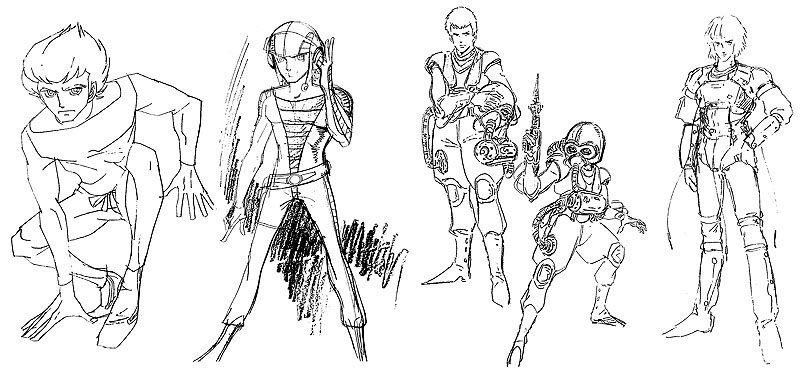
The Unchallengeable Daitarn 3: An early design for the protagonist Banjo Haran, drawn by Hitokazu Kokuni (a pen name for Tomonori Kogawa). This design drawing was then cleaned up by character designer Norio Shioyama.
In terms of design, Banjo's battle costume is essentially unchanged in the final draft. From the start of planning, the aim was "a robot anime version of 007," so the protagonist was established as a young man.
Armored Trooper Votoms: Design drawings of the protagonist Chirico Cuvie by character designer Norio Shioyama. The chest tank connected to his helmet is striking, and the tubes on his arms were meant to be plugged in while inside the robot.
Heavy Metal L-Gaim: A design drawing of the protagonist Daba Myroad. It was drawn by Mamoru Nagano in August 1982, at which point the title was "Mugen Star." The belts wrapped around his arms and knees are supposed to be anti-G bands to prevent backflow of blood.
Translator's Note: As above, I've focused here on translating the parts that provide critical analysis or behind-the-scenes production info.
Story • Following the traditions of his royal family, Prince Edward Mito, heir to the planetary kingdom of Edon which rules many other nations, goes out in disguise to inspect each of its planets. But evildoers run rampant on every planet, like local lords who exploit their power to persecute the weak, and money-hungry space merchants! Together with his loyal retainers Duke Skede and Baron Karks, Prince Mito uses the giant combining robot Daioja which has been passed down through his family to eradicate these evildoers.
Commentary • A work of light entertainment which incorporates the flavor of the well-known historical drama Mito Kōmon into a robot anime. The image of the protagonist as a compassionate person who loves justice, and the heartwarming story development in which good is rewarded and evil punished, made this a robot anime which could be safely watched by the entire family. With Katsutoshi Sasaki continuing on as director from Trider G7, it started on January 31, 1981, airing at 5:30 PM Saturdays on the Nagoya Broadcasting Network. 50 episodes total.
Staff •
Cast •
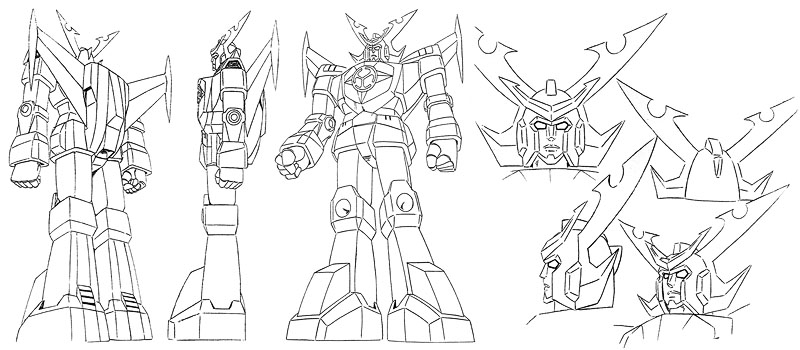
Daioja: A Sunrise "robot with a mouth" in the tradition of Daitarn and Trider. The silhouette of its overall body is also a direct descendant of those two.
Head: As well as incorporating a decoration inspired by Japanese helmets, the head also reflects the three-leafed family crest of the Tokugawa family. This is a good example of how well the robot's design matches the world of the story.
Clover continued on as a sponsor from the previous program. Toys were released that combined just as they did on TV, but their forms prior to combination were problematic, and the so-called standard types without combination gimmicks ended up selling better than the deluxe types.
At the proposal stage, the names of the robots before they combined were "Prince Ace," "Suke Robo," and "Kaku Robo." The characters were named "Prince Mito," "Suke Duke," and "Kaku Baron" respectively. In the actual show these were slightly different, but the image of "old Prince Mito" and "Suke-san and Kaku-san" was already in place at this stage.
I created the name "Daioja" from the idea that, after touring various nations, the prince will eventually become a great monarch. (1) As for "Mightiest Robo," I'd actually been thinking about that since the time of "Zambot 3," and it was someting I'd set aside for when I couldn't come up with an interesting subtitle. (laughs) (2)
Though real robots had become the mainstream at that time, the previous Trider G7 had been well-received, so we decided to once again go with an approach aimed at children. Having three robots combine into a single giant one worked well in the anime, but it seems it was hard to reproduce that in a toy with the technology of the time, so unfortunately it was somewhat imperfect as a product.
All I was given by Sunrise was the coded description "the A robo, B robo, and C robo combine to form the D robo." (laughs) It felt like I was free to do as I pleased from there... So it was fun fitting them together like puzzle pieces.
I believe I'd heard ahead of time that Daioja would be a story like Mito Kōmon, and that the robot would be a substitute for the seal case. (3) That's why I put a three-leafed crest on its chest. I gave the horns on the head a three-leafed motif as well. Since Mito Kōmon was the template, the robot itself was designed with a more Japanese image as well.
Because TV anime frequently uses recycled stock footage and horizontally flipped film, the mechanics are often designed to be bilaterally symmetrical, so as not to create problems on these occasions. Likewise, Daioja used a combination concept of "stacking from below" to make sure the robot was symmetrical.
Since the plan was based on the idea of a robot anime version of Mito Kōmon, these two versions of the main robot from the planning stage already have a three-leafed crest mark on their chests. At the planning stage, the three combining robots were designed as a samurai type, a gunslinger type, and a Roman warrior type. Thus each would have distinctive performance and visuals.

Story • In the year S.C.152, a war of independence breaks out on the planet Deloyer, a colony of Earth. Crinn Cashim, the son of the Earth Federation Council chairman, has doubts about his father's policies. Joining up with the guerilla group "Fang of the Sun," he becomes the pilot of the Dougram. For Crinn, this is also a fight for independence from his father...
Commentary • The first in a real robot series directed by Ryosuke Takahashi, this ambitious work depicts people caught up in the currents of history during Deloyer's war of independence. With the weapon-like aspects of the combat armors highlighted even more than in Mobile Suit Gundam, and the drama placing an emphasis on the world of politics, it incorporated viewpoints never seen in traditional anime. Because the first episode was designed to explain the basic setting of the complex story to the viewer, it also had strong elements of a pilot film. It aired at 6:00 PM Fridays on the TV Tokyo Network (changing to 5:55 PM as of episode 20), running from October 23, 1981, to March 25, 1983. 75 episodes total.
Staff •
Cast •
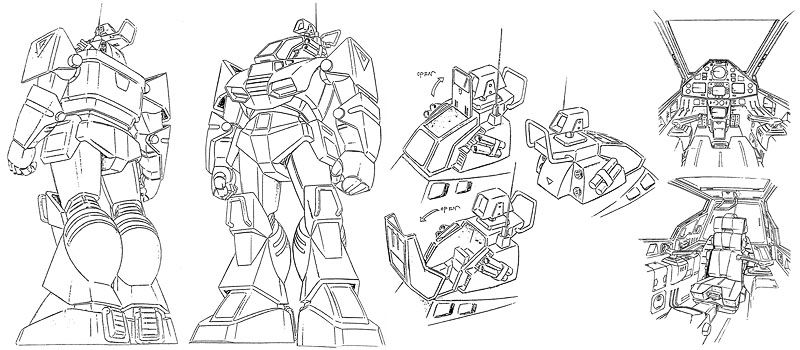
Dougram: The design has a heavyweight feeling very typical of Kunio Okawara. The head's lack of facial features makes the Dougram seem more like a weapon.
Head: The cockpit design actually originated from construction machines such as bulldozers, in which the operator's location is visible. It took on its current form by adding the flavor of things like combat helicopters.

Pose collection: Perhaps because it was designed to prioritize its image as a weapon, no common "hero robot" poses such as punching, kicking, and jumping were drawn. The design extended even to the soles of the feet, which were seldom seen onscreen. There had never been a robot with such detailed setting, which shows how it was striving for realism.
Character comparison: The Dougram's overall height of less than 10 meters made it about six times human size. This was because excessively huge robots were unrealistic as weapons operated by lone individuals. See our interview with director Ryosuke Takahashi for further details.
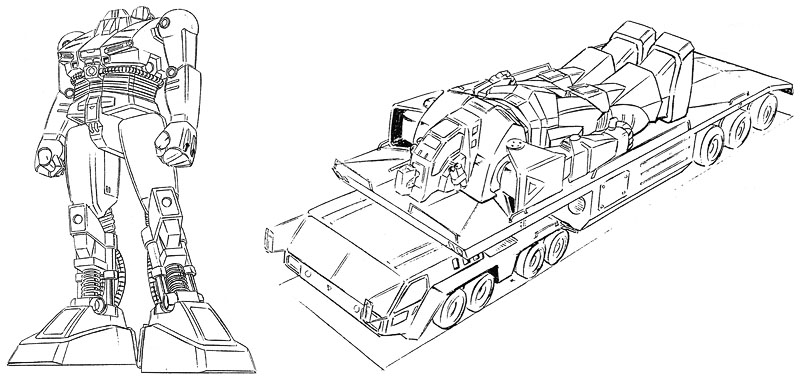
Internal drawing for cutaway model: This internal cutaway setting was created for use in the toys, and it differs from the setting of the Dougram's interior in the anime itself. In particular, the spring-like details in the ankles were included specifically for the toys. As well as plastic models, the three-dimensional Dougram toy releases included Dual Models made from hybrid plastic and die-cast metal materials, and 1/144 scale die-cast models.
Federation Forces trailer: The Dougram was loaded onto a large trailer for long-distance movement. The members of the "Fang of the Sun" guerilla group also moved between battlefields by riding on this trailer. The song the "Fang of the Sun" members sing in the show, "West, East, North and South," is a parody of an insert song from the classic Japanese movie Westward Desperado.
In terms of mecha setting as well as drama, this work could be called another step forward for the real robot approach that blossomed in Gundam. The main robot was portrayed purely as a tool rather than as a hero, and viewers were particularly shocked by the first "faceless robot" in anime history.
The main sponsor was Takara, returning to robot anime for the first time in a few years, and since the plastic models and other toys sold well, it was decided that the broadcast run would be extended. In the end, it became exceptionally long-running work with a total of 75 episodes. In July 1983, a theatrical version called Document Fang of the Sun Dougram was also released, in which the TV version was re-edited to look like a newsreel.
Up until the Dougram, the main mecha of a Sunrise robot anime always included some kind of combination or transformation gimmick. This could be considered inevitable for the robot anime of the time, which coexisted in a relationship with the toys, but from the middle stages of planning the setting concept for the Dougram was "a robot that doesn't combine or transform."
The production side took this "non-transforming approach" because, after the success of Gundam, they felt a robot anime aimed at older audiences might be possible. In other words, they were trying to make "mechanical believability" the main appeal of both the toys and the work itself, rather than flashy transformations and combinations.
On Dougram, by the time of my first meeting with Takara, they'd already come up with the idea of a toy where "it has an internal structure, and armor parts are attached to it." The concept was to eliminate the transformation and combination that were common in robot shows, and Takara's idea was that we could achieve play value for the toy by reproducing the internal mechanisms in a Dual Model. I think we felt that if we used transformation and combination instead, it would seem childish and wouldn't create the authentic military feeling we were aiming for.
As for the faceless design, I wanted to try creating something new. The sponsors okayed it, and I don't think Sunrise had any particular requests for the mecha design. Come to think of it, a little while after Dougram, I half-jokingly drew a Gundam with a cockpit for its face as well. (laughs)
When the planning of Dougram started, it had tentative titles like "Space Buffalo" and "Zactics." The final title "Dougram" is supposed to include the nuance of the word "Zigzag," with the image of guerillas who move between battlefields as they fight. (5)
At a very early stage of planning, consideration was also given to robots based on traditional toy-like concepts such as "a small transforming machine combines with the robot to form the head" or "the main robot combines with a transforming transport craft." However, as the plan itself progressed with a clear emphasis on "military flavor" and "a realistic approach," these kinds of toy-like ideas naturally disappeared.

Right: This early design idea for a Federation Forces combat armor creates a futuristic impression compared to the blocky Dougram. From the antennas on its head, it looks like it could function even without a pilot.
Story • A story set on Earth, now known as the planet Zora. When Jiron Amos tries to steal the new walker machine Xabungle to avenge his family, he meets a girl named Rag of the Sandrats, and Elchi, the captain of the giant landship Iron Gear. Jiron joins them on a trading journey, and they eventually find themselves confronting the mysterious entity Innocent which controls Zora.
Commentary • A unique robot anime with a strong Western-movie flavor. Unlike previous real robot shows, the screen is filled with the antics of characters bursting with vitality. As the series continued, the lightness of the first half disappeared, and the second half developed into something fairly heavy with a theme of humanity's revival. Due to things like the replacement of the main mecha, fans spoke of this work as "the pattern-breaking Xabungle." It aired at 5:00 PM Saturdays on the Nagoya Broadcasting Network, running from February 6, 1982, to January 29, 1983. 50 episodes total.
Staff •
Cast •

Xabungle: A relatively large model of walker machine. The fact that its cockpit is completely covered by armor shows that, unlike other walker machines, it is specialized for combat.

Pose collection: Because the designs for Xabungle were based on a concept similar to traditional hero robots, it seems this pose collection was meant to look cool and heroic. However, these typical super robot poses were all but irrelevant to the pattern-breaking program Xabungle.

Xabungle combination system: According to Director Tomino, the Xabungle's combination and transformation pattern was far removed from the approach he intended to take with this work. Perhaps for this reason, there were few scenes in the TV series which depicted the Xabungle combining or transforming.
Not just with Xabungle, but with all Sunrise robot anime at the time, the usual format was that after the concept of the robot had been fixed by the planning office, the individual director who'd been placed in charge would then create their own worldview and story. Thus, even before Director Tomino was involved, it had already been decided that Xabungle would be a work which starred combining and transforming mecha.
However, because the design and the combining mechanism of the main mecha Xabungle lacked novelty, setting was created for the giant robot Iron Gear as well. The Walker Galliar was introduced in the second half due to the wishes of Director Tomino, who felt the Xabungle didn't match the work's worldview, and the sponsoring toymaker Clover's request that a second robot show up.
The Walker Galliar, which was introduced in episode 26, was the first "new main robot" in the history of robot anime. Having a second robot now feels like a standard convention, but at the time the idea of a second robot didn't exist even in tokusatsu programs, and it was a truly novel concept.
The Walker Galliar was designed by Tomonori Kogawa, the character designer, and the final draft had already been competed by April 1982, two months after the start of broadcast. After this work, replacing the main mecha would become part of the pattern of Sunrise robot anime.
The design of the Walker Galliar was based on a truck that actually existed about 30 or 40 years ago. (6) Its characteristics can be seen especially clearly in the fact that the lower body, the Galli Wheel, is a three-wheeler type. It's hard to call this a stylish design, but given the stage setting smeared with dirt and dust, it really feels like a walker machine and is well-matched to the image of the work itself. In addition to Clover's toys, Bandai also released this as part of its High Complete Model series.
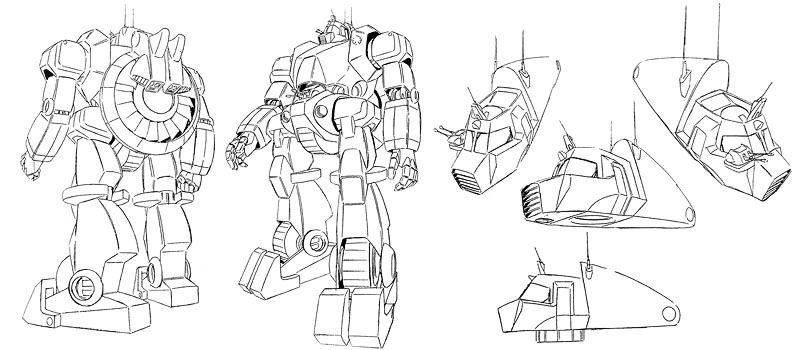
Walker Galliar: Director Tomino's request for the mecha design was "something with an interesting silhouette." This desire is reflected in the Walker Galliar's design.
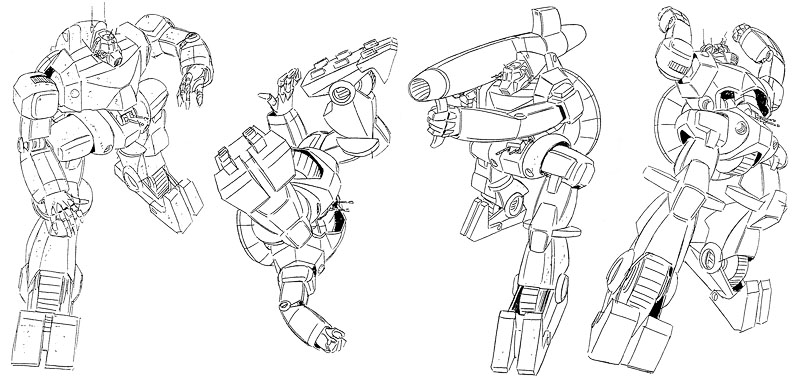
Pose collection: Unlike the Xabungle, which was designed with limited moving parts because of the emphasis on its combining and transforming features, the Walker Galliar is designed on the assumption that all its joints should move.
As far as the transforming and combining gimmicks of the main mecha, I didn't have any particular requests from the sponsor Clover. We proceeded with them either okaying or rejecting whatever I'd created. Clover wasn't involved in the details of the plan itself, either, and I think Sunrise took the lead on that.
The Iron Gear, one of the main mecha, was a very big robot. But I wasn't really conscious of exactly how many meters it was. After all, when you're making comparisons to robots, that's determined by the size of things like boarding hatches. If it's something with windows, then it's decided based on the size of the windows. So if there are no points of comparison, it's all pretty vague, and it doesn't really matter whether it's ten meters or twenty.
When Xabungle was on the air, plastic models with realistic markings and molding were becoming popular. Thus, for this work, setting was also prepared to add detail to the main mecha.
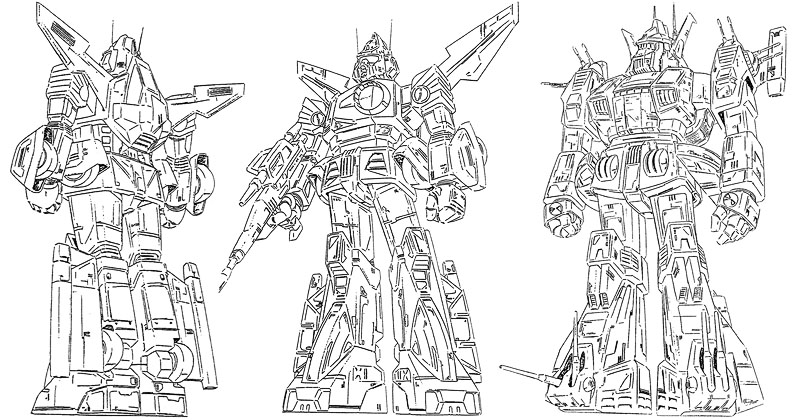
Xabungle was the first time Bandai participated as an official sponsor of a Sunrise robot anime. The merchandising was divided up with Clover doing the alloy toys and Bandai doing the plastic models. The plastic models were designed to prioritize the gimmicks depicted in the model sheets.
As for the mecha design, the initial main mecha Xabungle and Iron Gear were by Kunio Okawara, the second robot Walker Galliar and some of the walker machines were by Tomonori Kogawa, and Yutaka Izubuchi was responsible for various walker machines and landships.
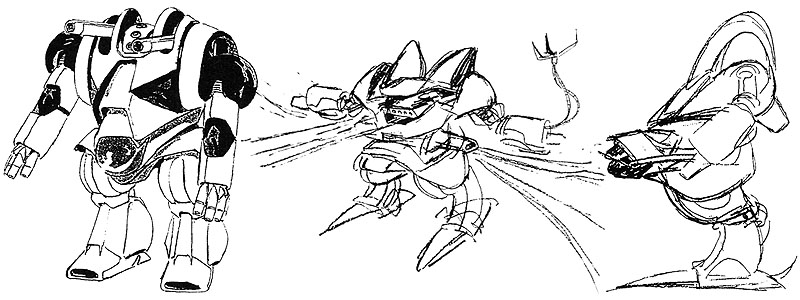
Walker machine rough collection: A selection of walker machine rough drafts by Tomonori Kogawa. The three shown here were drawn around February 1981, about one year before the broadcast. In other words, the planning was already in progress right after the broadcast of Space Runaway Ideon ended. Though walker machines are used for excavation, at this point the designs still gave a strong impression of being combat mecha.
Story • One day, a Japanese youth named Show Zama is suddenly drawn to Byston Well, another world between sea and land. Here, Show receives the aura battler Dunbine and the title of "holy warrior" from the local lord Drake, who is scheming to conquer Byston Well. But after Show learns of Drake's ambitions from Marvel, who has also come from the surface world, he decides to fight on the side of Drake's opponents.
Commentary • The first robot heroic fantasy in anime history. Its creativity could be seen in the depiction of the battles, where cavalry charges in after the aura battlers storm a castle. Also, while previous real robot anime was set in the future, in the second half of this story the aura battlers start to appear in the present-day world. The battles between aura battlers and real-world weapons earned popularity with their kaiju movie-like depiction. It aired at 5:00 PM Saturdays on the Nagoya Broadcasting Network, running from February 5, 1983, to January 21, 1984. 49 episodes total.
Staff •
Cast •
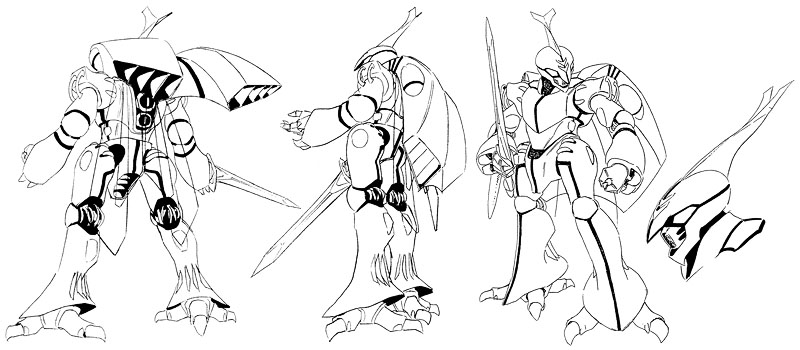
Dunbine: All three Dunbine units have different colors. Show's is pale blue, and the other two are painted dark blue and dark green. This was because there were plans to release toys in different colors.
The aura battlers were designed based on Director Tomino's request for "something with a strong character, instead of transformation and combination." The setting for their sizes is usually between seven and nine meters. This was deemed the minimum size for a robot that people could board and operate.
Though many aura battlers appeared during the series, it seems there were no plans for mass quantities of aura battlers to show up when the planning of this work began. This was meant to visually differentiate it from the mass battles with large numbers of mobile suits depicted in Gundam.
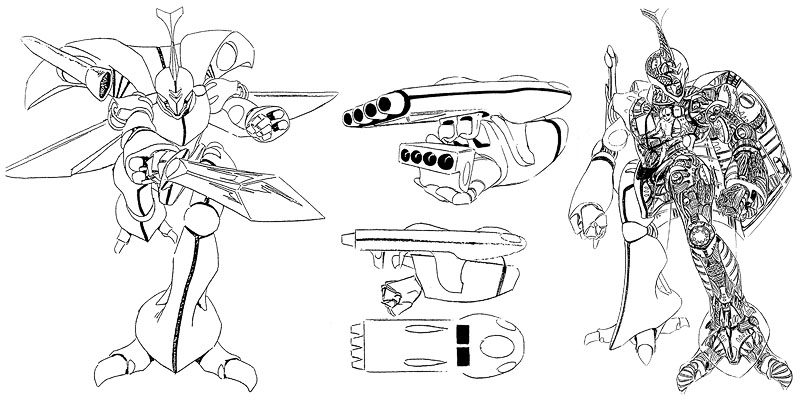
Armament: Since the Dunbine was originally designed to emphasize mobility, it could be said that its greatest weapon is its speed. Its armament consists only of a sword, wired claws, and aura shots.
Aura shot: The reason for carrying firearms in a world of sword and sorcery was the belief that guns were an essential item for a robot show, rather than a request from the sponsors.
Internal diagram: Aura battlers are humanoid weapons made by combining surface technology with body parts from the giant creatures of Byston Well.
This work was originally born from the idea of "making a robot show in a fantasy world of knights and fairies." The robot itself was meant to create a new line that was fundamentally different from traditional mechanical ones, and the very earliest design looked almost like a huge rock giant with a bird-like head. After this, it was decided that the robot would have an insect motif, and the style began to approach that of the final draft.
The Dunbine's cockpit was made semi-transparent due to a desire to make the pilot's body visible, and thus visually show that the protagonist himself was being projected onto the robot. There were plans to sell figures of the protagonist, so it seems this was also intended to raise their commercial value.
At the start of planning, this work was titled "Holy Warrior Sirbine," and an aura battler with this name appeared in an OVA version that was later produced. (7)

Billbine: The Billbine's design creates a more mechanical impression than other aura battlers. The large aura cannons on its back also reinforce its particularly toy-like image.
Head: Though the concept of an insect motif has become somewhat faint, a lot of the biological flavor remains in the head.
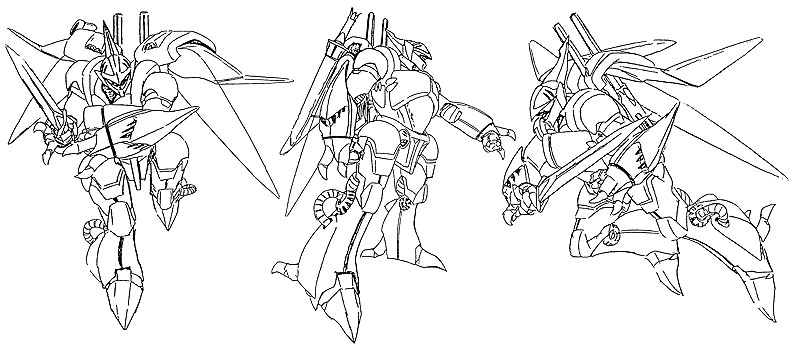
Pose collection: The Billbine was based on a new aura battler with an insect-like design drawn by the character designer Tomonori Kogawa, to which sponsor requests such as "put launchers on the back" were added. As a result, it ended up becoming very toy-like. As its name hadn't been decided when the final draft was designed, the tentative name "Neo Dunbine" is written in the setting materials.

Wing caliber: Though aura battlers are based on insects, the wing caliber's design is reminiscent of birds of prey such as eagles and hawks. The fact that its image changes during the transformation could be called a triumph of skillful design.
Director Tomino told me, "I want a main character that can fight its way through a fantasy world, while displaying a strong personality." He added, "I'll deal with the sponsors." I completed the design for the Fow before the Dunbine, and with that, we decided to go with insects as the motif. (8)
The coloring of the aura battlers was decided on the Sunrise side, but I didn't want to use ordinary red, white, blue, and yellow colors either. Regrettably, at the point where I'd drawn the Dunbine, Drumlo, Dana O'Shee, Zelerna, and roughs of a few others, I had to leave Dunbine due to other work.
Story • It is the end of the Hundred Year War that has split the Astragius galaxy in two. During an operation, a Melkian soldier named Chirico Cuvie witnesses a mysterious woman who is a military top secret. Because of this, both the military and a secret society begin pursuing him. When Chirico is eventually reunited with the woman, he gives her the name Fyana, and they fall in love. But an enormous conspiracy awaits them, which will involve the entire galaxy...
Commentary • Even more than director Takahashi's previous work, Dougram, this work emphasizes the robots as weapons. While main mecha are usually unique, in the world of Votoms the setting is that they're ubiquitous walking tanks, depicted purely as weapons for military purposes. This work could be called the pinnacle of real robot anime, and in episode 11, there's a scene in which Chirico discards his damaged Scopedog and transfers to another machine, showing that the main mecha is disposable. It aired at 5:55 PM Fridays on the TV Tokyo Network, running from April 1, 1983, to March 23, 1984. 52 episodes total.
Staff •
Cast •
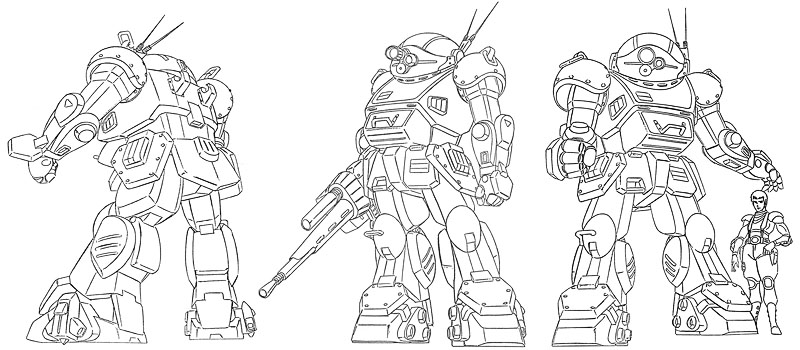
Scopedog: The main AT of the Gilgameth forces. According to the setting, since it's highly versatile and easy to produce, many variations exist. Its unique design resembles a walking tank.
The waist skirts are designed to allow a wider range of leg movement when recreated in three dimensions. The four-meter size of the AT appears to have been decided from the beginning.
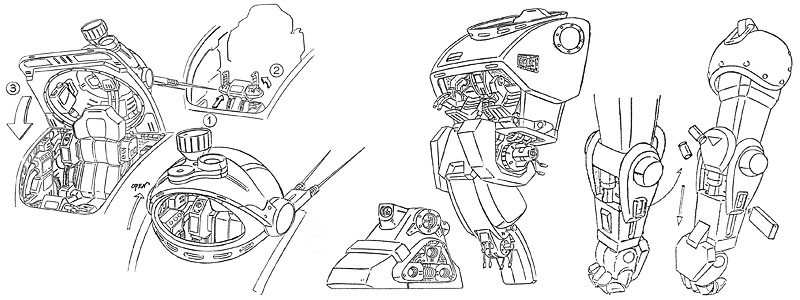
Head: The initial design for the AT was "a robot with only arms and legs, and an exposed cockpit for a head." But since this would have been too hard to move in animation, it was decided that the cockpit would be covered by a spherical visor.
Foot: The roller dash installed in the legs is used impressively in the story. This was born from the simple idea that driving wheels would be faster than two-legged walking.
Internal mechanisms: Nowadays, it may seem only natural to prepare detailed drawings of the internal mechanisms, but at the time these were often just "rough cutaways" and were seldom this precise.
Arm punch: The arm punch mechanism was invented as "a punch with no wasteful movement for the machine." A cartridge filled with gunpowder is used once and ejected. The principle is the same one used in firearms.
After the favorable reception of the previous Dougram, this work was planned as an even harder and more realistic mecha anime. The design of the robots prioritized their functionality as "weapons," and as a result, they became what could be called humanoid tanks. Incidentally, the landing mechanism used so effectively in the story was devised after the design was already completed.
The overall story was divided into Uoodo, Kummen, Sunsa, and Quent chapters, so exactly that even the background music changed from chapter to chapter. OVAs have also been produced every few years since the broadcast ended, and it still has loyal fans to this day.
At the start of planning, it was titled "The Warriors," and the story focused on battling competitors who traveled from place to place. There was also a proposal to include four-legged robots.
They're pretty small robots, but we did that thinking it would be the most attractive size when you put them in a plastic model diorama. Mechanisms such as the arm punch, roller dash, and turnpick were added after the design was decided, because Director Ryosuke Takahashi wanted to include them to add appeal to the dramatization.
I've also drawn a lot of illustrations for it. With things like Gundam, I have to be careful to make them look cool, but when it comes to Votoms, it fits the worldview if I draw them with a purely mechanical image. So that was fun.

Scale comparison: A chart comparing an AT to characters and other mecha. All these mecha, such as the security police armored vehicle, appear in the Uoodo chapter. Looking at it like this, we can see how much smaller the AT is than a traditional giant robot.
Story • In the year 2058, when humanity has begun settling the Ypzalon solar system 43 light years from Earth, the colonists are attacked by the Kukutonians. Thirteen surviving children head for Earth aboard the training ship Janus, using round vernians (RVs) to resist the pursuing enemy. Along the way, the children learn that their missing parents are captives of the Kukutonians, and set out out rescue them regardless of the danger.
Commentary • As Yoshiyuki Tomino says in the original plan, this was another attempt at an SF version of Two Years' Vacation, the initial idea for Gundam. Its lively depiction of children caught up in a war made it enduringly popular. While the warmth of Toyo Ashida's character designs was very effective, the RVs designed by Kunio Okawara were also well-received as toys. It aired on the Mainichi Broadcasting (TBS) Network at 7:00 PM Fridays from October 21, 1983, to March 30, 1984, and at 5:00 PM Saturdays from April 7 to September 8, 1984 (April 6 to September 21 in the Kanto region). (9) 46 episodes total.
Staff •
Cast •

Vifam: Verniers are installed all over its body for high mobility in outer space, and the curved body lines suitable for adjusting the angle of its nozzles give it a distinctive appearance. Because it is so easy to handle, even a child can operate it.
Pose collection: The defining characteristic of an RV is it can easily maintain these kinds of standing poses even in space. These provide a good view of the shape of the head.
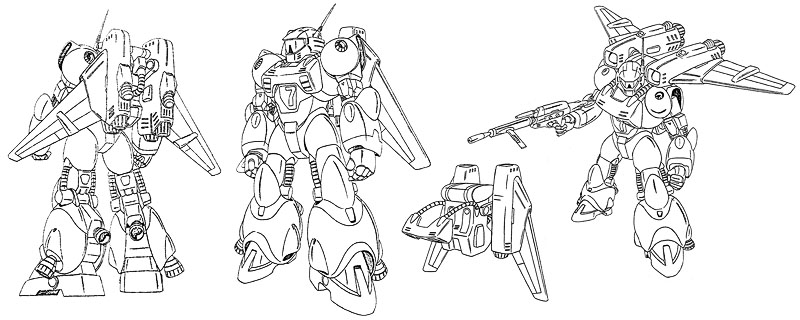
Sling pannier: RV attachments for atmospheric flight are known as "sling panniers," and this type is designed exclusively for the Vifam. When the space backpack is removed and this is installed, it can reach speeds of up to 740 km/hour.
Vifam, whose protagonists were children even younger than those in Gundam, was remarkable for depicting them purely as children rather than as heroes. From there, each of the thirteen children gained their own fans, laying the foundation for their popularity. And because this popularity also extended to the toy sales, the broadcast was twice extended when it was on the brink of cancellation. It's also memorable that High Complete Models were released in the course of the robot anime boom. (10)
As the popularity of the characters took the lead, the mecha didn't get as much attention in the work itself, and even in the setting the round vernians (RVs) seem to have been imagined as nothing more than "mobile suits with lots of verniers." Nonetheless, including the Kukutonian side, a great number of RVs appeared, creating many highlight scenes centered on battles in outer space. The 1998 broadcast of Round Vernian Vifam 13, which inserted newly created dramas into the old series, demonstrated anew the basic charm and approachability of this work.
Vifam was originally planned on the assumption the robots would be turned into plastic models, so from the beginning, the concept was that the robot wouldn't transform or combine. The reason it became a Gundam type was that our core concern was the development of plastic models, and we were aiming for a Gundam-like flow with the merchandising. But even though its silhouette resembled the Gundam, we gave it a face with hidden eyes to make the distinction clearer.
We initially gave it names like "Glados" and "Jados," but we changed the name because we couldn't get those trademarks, and it was Director Takeyuki Kanda who came up with "Vifam." Since Director Kanda has now passed away, Round Vernian Vifam 13 was created partly as a memorial to him.
On Vifam, I was responsible only for the main mecha, particularly the RVs. I had in mind that they should be easy for children to build when they were turned into plastic models. But in terms of design, as per the round vernian name, I just stuck verniers all over them for attitude control in outer space... that's honestly about it. (laughs)
As I started drawing, I made parts like the leg skirts into perfectly round spheres, and I thought that the verniers inside could point in any direction. I recall that the drawing went smoothly without my giving it much thought, but the toys were quite popular.
With fans embracing the real robot approach that began with the success of Gundam, a preference emerged for more detailed mecha designs. Here, we will highlight the RV design process, which went against this trend by aiming for "mecha that children can enjoy."
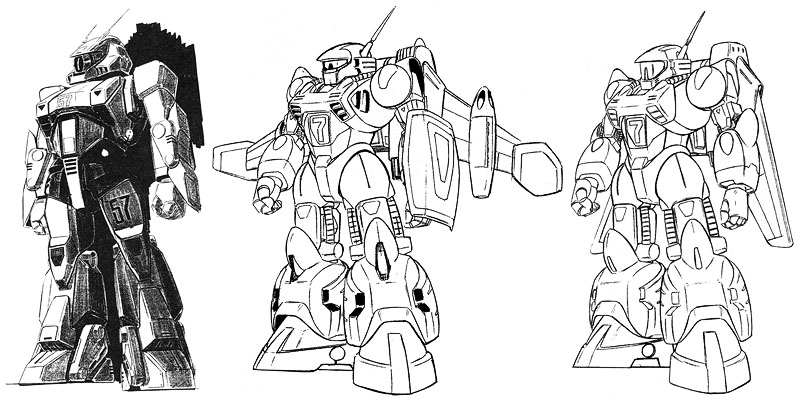
Vifam: The setting for the RV, as a humanoid mobile weapon for space combat, overlapped with the mobile suit, and so the design inevitably started with a form similar to an MS. The design of the main mecha Vifam likewise changed from an MS to an RV. (Design: Kunio Okawara)
Left: A Vifam preceding the versions covered with verniers. Differences from MS can be seen in things like the camera eye.

Neofam: The early Neofam designs weren't distinguished from the Vifam, and technically we can't really call this a Neofam. The initially exposed verniers were later scaled back to a fairly inconspicuous form. (Design: Kunio Okawara)
Center: Though this has a Neofam head, it still has a Vifam body. After this, the body was changed to be more angular.
Dillfam: The spherical shoulder and leg parts seen in the earliest Dillfams eventually took on proportions that took advantage of their roundness. The basic RV design was now finalized. (Design: Kunio Okawara)
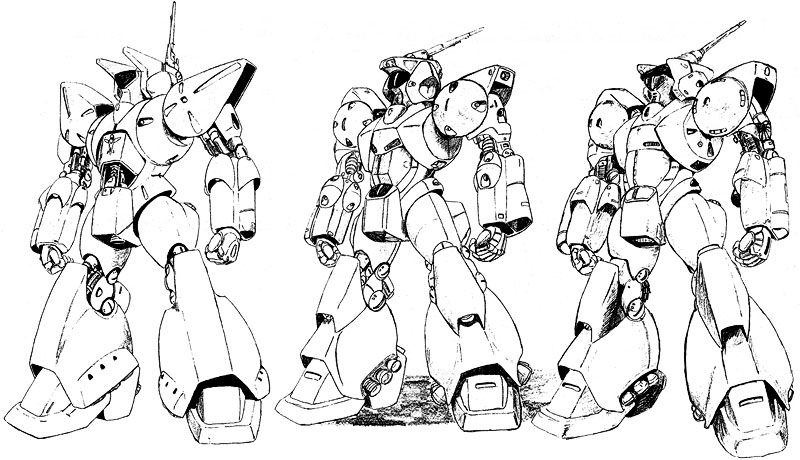
Earth RVs: Rough drafts of Earth RVs by a guest mecha designer. In the rightmost two, the forms of the lower body share the concept of Kunio Okawara's designs. These are all distinguished by their compact verniers. (Design: Mamoru Nagano)

Kukutonian RVs: Here we introduce rough designs for enemy RVs, including some that exist only as drafts, which seem to have been based on images that would frighten children. (Design: Kunio Okawara / Wug and Buzam, Mamoru Nagano / Aden and others)
Wug: The basic silhouette is almost complete. The details change after this, and the final draft includes detachable wings on the back.
Buzam: Most of the distinctive features of the final draft, such as tentacle-shaped sensors and backpack verniers, are present in this rough stage.
Aden: An original RV. From the characteristics of its form, it seems to be the basis for the Buzam.
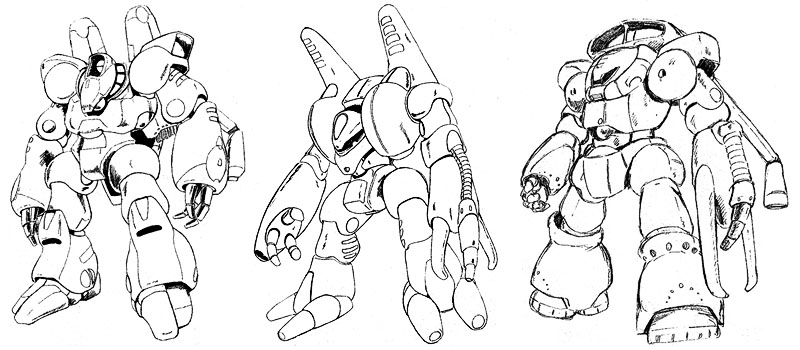
These three are RVs that exist only as rough drafts. Their forms consist almost entirely of curves, and even given that these are concepts for enemy RVs, they have a biological feel.
(1) The name is presumably a compound of 大 (dai) meaning "great" and 王者 (ōja) meaning "monarch."
(2) Though the full English title is Robot King Daioja, the Japanese subtitle 最強ロボ (saikyō robo) literally translates as "Mightiest Robo."
(3) In the Mito Kōmon series, the adventures typically conclude with the hero showing off the seal case that serves as proof of his aristocratic identity. The appearance of the robot plays the same role in a Daioja episode.
(4) The Japanese text here credits Takahashi as sole director, but in fact he was initially credited as co-director with Takeyuki Kanda up until episode 31, and Kanda was listed as sole director for the remainder of the series. I've corrected this in my English translation.
(5) No, I don't see the connection either. If anything, the title "Dougram" seems closer to the Japanese word 企む (takuramu), which means "to scheme" or "to plot."
(6) In other words, around 1960 to 1970. There were several types of three-wheeler pickup trucks in production at this point, but the Mazda T1500 and T2000 models introduced in the 1960s bear a particular resemblance to the Galli Wheel, and the standard green colors of the T1500 are very close to those of the Galliar.
(7) The Japanese subtitle 聖戦士 (seisenshi) is literally "Holy Warrior," but is rendered as "Aura Battler" in the official English title of the resulting series.
(8) The Fow is a support vehicle, or "wing caliber," used by the Dunbine.
(9) This schedule change took place after episode 23, which was followed by two flashback compilation episodes.
(10) In June 1984, the Vifam and Neofam were part of the first wave of releases in Bandai's High Complete Model series, alongside the Gundam Full Armor Type and MS-06R Zaku II.
Director Ryosuke Takahashi continues to tell stories of tough men in worlds that combine robots with narrative. He spoke to us about his works Dougram, Votoms, Galient, and Layzner, discussing their planning, the sources of his ideas, and his recollections from the time.
PROFILE
The director of the 1973 TV anime Zero Tester, which is considered a hidden masterpiece. Going on to works such as New Cyborg 009, and then bringing the real robot series Fang of the Sun Dougram and Armored Trooper Votoms into the world, he had a great influence on later robot anime.
I came up with the sound of "Dougram" at a very early point. Actually, I really wanted to use the title "Zigzag," which suggested guerilla warfare that doesn't move in a straight line on the battlefield. However, there was already a "Zigzag" in some other trademark, so it was no good. I really liked it because I thought we could make a cool title logo by writing "ZIGZAG" in the Roman alphabet, but...
As for the subtitle "Fang of the Sun," from the beginning I was thinking about a story where the protagonist fights alongside guerillas. So I called it that because he's a natural being, not an artificial one, "baring his fangs at the system."
At the time, robot shows tended to identify the robot's persona with that of the protagonist, but I always thought that "humans are humans, mecha are mecha." For commercial reasons we had to put the robot's name in the title, but I felt that in the end the humans were the protagonists.
But that doesn't mean I was trying to exclude or disavow previous robot shows. It's just that when I thought about setting out to create a new work, I naturally tended to separate the robots from the humans.
I don't remember exactly when it was... By the time I joined, it seemed like Mr. Okawara had largely settled on the design of the robot. It was an innovative one with no face, and personally I was very pleased with the design, since I wanted to bring out the reality even in a ridiculous robot show.
No, at first it was the influence of Gundam, which was airing at the time. I only happened to see it once or twice, but the parts where the robots appeared as weapons on the battlefield felt quite realistic as entertainment. I wanted to try following that up with my own kind of story and my own kind of narrative setting. I thought that the robots should be purely vehicles made by human beings.
I thought that if there were a civilization that could travel into outer space, then humans would turn their colony planets into the most comfortable living environments they could. Aside from unseen technology such as heating and cooling, I figured they'd set up an everyday lifestyle closer to the atmosphere of the 19th century. But that's a rather forced rationalization because I don't have a proper grounding in SF. (laughs)
That's a different matter. I guess I wanted to depict guerilla warfare in arid regions like deserts. For some reason, I also had an impression of the colony as a place filled with burning sand.
That's right. If the director had wanted it to transform or combine, that could probably have been done, but I didn't have any such inclination. (laughs) So we decided to go ahead with the original non-transforming one. Where the robot was concerned, I was conscious of wanting to maintain its size as a vehicle. For instance, personally I find the idea of a fifty-meter humanoid hard to accept. (laughs)
No, with Dougram it didn't cause any problems. In those days I still had plenty of ideas, so I felt like I could keep going as long as they wanted us to continue the story. The plastic model sales and audience ratings were both really good, so the sponsor Takara didn't meddle in the content at all.
I was working on it from the very beginning. It had been decided to do another robot show as a followup program to Dougram, and Votoms was the plan I came up with. (1) Even the design of the mecha reflected my own inclinations.
When I was working on Dougram, I realized that in directorial terms it didn't matter whether the size of the robots was ten meters or fifty. So for the next work, I wanted to make them either more than fifty meters, or less than ten. Since there were already so many big robots, I thought that rather than making the robot something special, it should be about four meters tall and positioned like a jeep or an armored vehicle.
Then, when I first met with the designer Mr. Kunio Okawara, he said "I've been thinking of a robot like this" and showed me a mockup of a robot consisting only of arms, legs, and an exposed cockpit. It was close to what I'd been thinking of. Even if we put armor on the cockpit, it would only be about five meters, so the size was good as well. One way or another, I wanted to use it.
That's right. When a robot strikes an enemy, I thought a sliding mechanism would be sufficient. Then we gave it a military flavor by using gunpowder for the sliding energy and ejecting it afterwards.
As for the roller dash, I wanted to somehow create action with a sense of speed. I thought about hovering or antigravity, but nothing quite clicked. When we were children, all our toys had tires, so running around with rollers on your feet had a strongly negative image. But from the beginning, I'd felt that sound was very important from a directorial standpoint. I thought that if we could supplement it with sound effects, then adding a mechanism that let you dash in straight lines down the streets of a well-maintained future city wouldn't hurt the realism, and so we adopted that.
Actually, it was supposed to go only in straight lines, but along the way the episode directors started making it go in zigzags. I thought that was no good, but to my surprise it looked really cool, so I said "Well, okay then." (laughs)
We did a faceless robot in Dougram, so this time I wanted to give it some expression. Since the robot is a weapon, it should have a cold expression, and that expression consists of "sensors to precisely confirm the enemy." They'd already used the mono-eye for the Zaku in Gundam, so I figured if we gave it a turret lens in which each had a different function, their movement could create expression.
Another reason was that I really wanted a microscope when I was a kid. (laughs)
That's because I really got into making robot anime.
I'd actually been intending for some time to quit doing anime. I didn't particularly like robots, and I did't know anything about SF. I also had a strong feeling that I'd been forced into doing Zero Tester and New Cyborg 009, my first works as a director, for Sunrise's convenience because there were no other suitable candidates. I'd been working on anime with this sense of reluctance, but thanks to Dougram, I discovered the joy of creating an original story within the constraints of TV anime.
Even though it was a robot show, it was the humans I wanted to depict. Because the people riding the robots were at the lowest level of society, leading a "life or death" existence, I called it "Bottoms." (2)
First came a vague worldview, and then it felt like all the other parts gradually came into focus. I think the basis of the planning was that there were two possible directions. One was a giant robot story, whose details I no longer remember, and the other was a Votoms-like story about individuals where the robots were smaller. I wasn't sure which we should do, and I discussed it with Director Tomino, who said "It's definitely this one!!" in reference to the Votoms idea. So I replied "Of course it is." (laughs)
We'd decided from the beginning to change the setting over the course of the one-year broadcast. During Dougram, the sponsors said that the background art was't science-fictional. So we were trying desperately to make it more like SF, but ideas don't come to you that easily. Then we figured "Let's come up with every kind of world that people will think is science-fictional" and we put them all in. (laughs)
That's because the fun of making original works is adding some new flavor to each one. I did it with the feeling that my next target should be my own version of a Western-style sword and sorcery world, in the so-called fantasy genre. But looking back on it now, it was a little ahead of its time.
Because Votoms had struggled a bit in commercial terms, the sponsors had a lot of input on Galient. That's why the robot had a face, and it transformed as well. (laughs) It had roller dash even though it was such a big robot, the whole thing was colored red, and other things I hadn't intended were incorporated.
I'm fond of the robot itself, and I was very pleased with it. I still clearly remember the scene of its first appearance, but I thought "Huh, didn't it transform or something?" (laughs)
I came up with that because I wanted to give it something new. They used beam sabers in Gundam, and I didn't want it carry a sword on its back, so I began by thinking about things like Nankin-tamasudare. (3) (laughs) But I couldn't think of a name for it, so I said "Jarajara sword will do, right?" (4) (laughs) In the end, we never gave it an official name.
Speaking of armament, we gave it a cannon along the way. But that was for business reasons, and to be honest, I didn't want to do it.
That's right. We made the protagonist a child partly because the merchandising had shifted from plastic models to alloy toys, so I decided to make him an energetic boy.
If the feelings of the sponsors and other people involved had been reflected a little more, I think it would have become a straightforward work in which good was rewarded and evil punished. But that didn't happen, because I was directing it. (5) (laughs)
As part of Sunrise's business plan, they'd already decided that "Takahashi will be doing this next." (laughs)
The starting point for my robot shows is that "the robots shouldn't feel out of place within the story." In my own way, I have to make the robots seem not so strange, or I can't come up with a story.
So with Galient, I thought it might be acceptable if the robots were relics. Once I'd decided they were relics of the past, I created a story about "the revival of a humanity that's lost its vitality."
Both I and the character designer, Mr. Norio Shioyama, were very fond of Mardoul. I always have a theme of "fathers and sons," and even if they're not literally parent and child, he's a father figure serving as an obstacle to train the boy, who takes some hits but eventually overcomes him...
But maybe that's my weak point. Certain audiences will really get the idea of not making the enemy totally villainous, but it doesn't carry over to anyone else.
No, it didn't. I had a lot of discussions with Mr. Okawara about things like making the head resemble an aircraft canopy. Before I started on Layzner, I'd been wanting to try doing a robot that was a tool but had a will of its own. So I decided on the setting that there's a personality called Phoron inside the robot.
Well, we were obligated to have a power-up. But I didn't want to do a big transformation or remodeling as usual. (laughs) So we came up with the V-MAX setting during the broadcast, adding the setting that it was built into the robot from the beginning and just hadn't emerged at first.
I'd been wanting to do that, but thinking about it now, perhaps it was an evasion. With Votoms we were aggressive in changing the stage, and I guess since it had worked before, I thought I should change up Layzner as well. When it came to things like the fine details of the work, I might not have been able to make those connect logically.
Hopefully, a work becomes interesting thanks to the collision of different elements, whether story or design. But with Layzner, I feel it remained half-baked, and we couldn't bring out the value of gathering all those people to create a work. We had to devote energy to building a world that unified the story, the characters, and the robots, but it seemed like the energy was always leaking out of it.
As for the characters, I was personally fond of Gresco and set up a three-sided parent-child relationship, but I can't say the whole thing was well integrated. I remember being full of regrets as I made it, and it's a work that still gives me heartache.
Actually, there was one other work in between Galient and Layzner. Since the robots I depict seldom fly in the sky, this was a work in which they fly through outer space, clad in ceramics and using beam cannons as armament. But we jumped in too hastily, and it was cancelled when we'd already drawn the key art for about two episodes. (6)
So I ended up doing Layzner, which had been in development at the the Sunrise planning office. But things like the title incorporated ideas left over from that cancelled robot show. The name "Layzner" evokes the image of optical weapons such as odorless lasers. At the time, wedge-shaped rectilinear forms were popular even in cars, so it was an era where round robots seemed old-fashioned. I also gave it the subtitle "Blue Comet," thinking that I should try something so pretty it was a little embarrassing. (laughs)
It's not that we shouldn't overlook it, but there's one point that's come up here. It's that the protagonist doesn't achieve greatness at the price of their independence. In other words, they don't want to rule, but they don't want to be ruled by others either. In the same way, I've worked to some extent with organizations, but ideally I don't want to be tied down to them.
Of course they want to be free, but nonetheless I think they don't want to be isolated, to rule or to be ruled, and they want to have comrades by their side. They do things when they want to, and when they don't want to, they don't. (laughs)
When it comes to actually making a living, you want to have the fangs to live your own life. (7) Unless you have some kind of fangs or weapons, they'll say "Come to my place and I'll feed you," you'll reply "I see, thank you, kissy kissy" and you end up being ruled by others. (8) (laughs) In other words, you'll lose your freedom.
When you say "I don't want to do this job," the question is whether there are other jobs you can do. That's a bit contradictory, of course, but nonetheless I think human beings should be united in mind and body. So 20% are things you have no choice about, and the other 80% you should do do of your own free will. To become independent, you have to acquire strength, methodology, and an environment that makes it easy for you live. Even though it's indirect, I'm projecting that onto my characters as I create my works.
(1) In the Japanese text it's often unclear whether actions should be attributed to "I" or "we," but Takahashi specifically refers to himself in the following sentence, so I think it's implied that he came up with the plan as well. The later anecdote about his conversation with Tomino also supports this.
(2) The Japanese title ボトムズ is officially spelled "Votoms," but it can also be read as "Bottoms."
(3) Nankin-tamasudare (南京玉すだれ) is a traditional form of Japanese street performance involving a screen of woven sticks that can be twisted and extended into various shapes.
(4) Jarajara-ken (ジャラジャラ剣) could be translated roughly as "jingle-jangle sword."
(5) The Japanese phrase 勧善懲悪 (kanzen chōaku), literally "encourage goodness, punish evil," is a genre cliche mentioned above in the context of Mito Kōmon and Daioja.
(6) I believe this cancelled project was Dystopia Story Stealthwise, various elements of which were repurposed for Layzner.
(7) The Japanese verb 生活する (seikatsu suru) encompasses meanings like "live one's life," "spend one's life," and "make a living." Takahashi seems to be speaking here mostly about managing a career, but I've phrased this in more general terms since it also applies to his characters and doubles as the title for the overall interview.
(8) The phrase ヘコへコ (heko-heko) is a sound effect that represents sucking up to a superior. I've translated it here as "kissy kissy."
Translator's Note: As above, I've focused here on translating the parts that provide critical analysis or behind-the-scenes production info.
Story • The Pentagna World is dominated by Oldna Posaydal. Daba Myroad, heir to the Yaman royal family, decides to join the rebel forces and fight to overthrow Posaydal's tyranny and revive his homeland.
Commentary • The unique visual sense of this work made a lasting impression, thanks to character fashions brimming with originality and robots whose designs were a clear departure from traditional giant robot heroes. It aired on the Nagoya Broadcasting Network at 5:30 PM Saturdays, starting February 4, 1984. 54 episodes total.
Staff •
Cast •
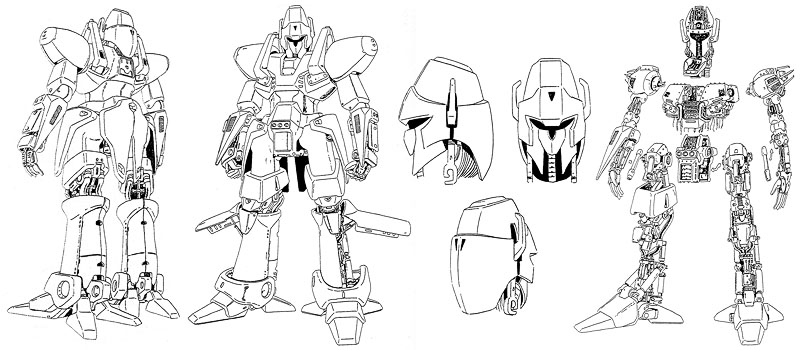
L-Gaim: With its white body, simple face, and rear armor on its waist that resembles a tailcoat, its overall design gives a noble impression worthy of a machine ridden by the heir to the Yaman royal family.
Movable frame: The movable frame could be called the guts and skeleton of an A-class heavy metal. There are three general categories—the S (small) frame, M (medium) frame, and L (large) frame—with the L-Gaim using an M frame.
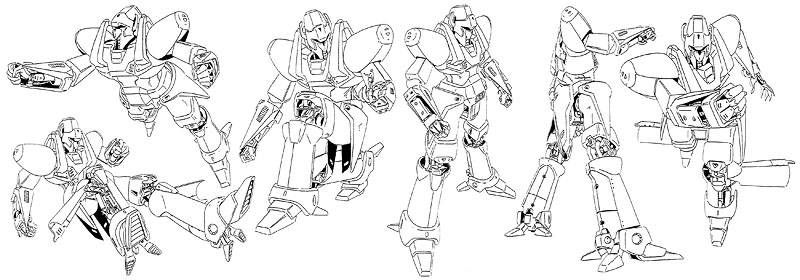
Pose collection: New experiments such as double-jointed elbows and knees, the rubber in the torso section, the split heels, and so forth are applied throughout the body for a more realistic depiction of the mecha.
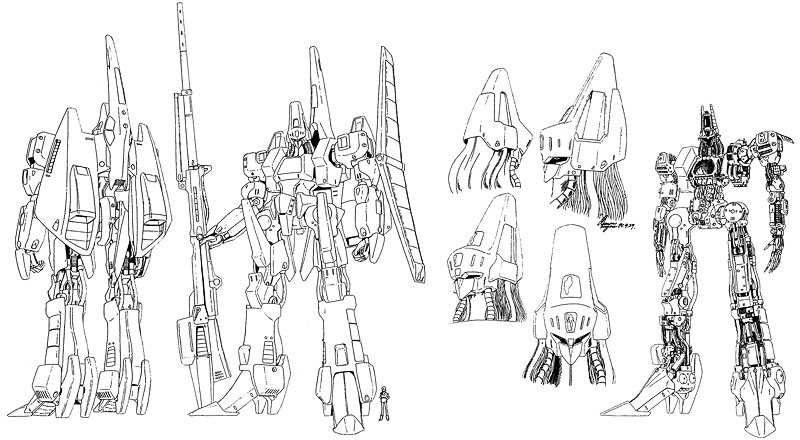
L-Gaim Mk-II: An A-class heavy metal introduced in episode 28, which becomes the symbol of the rebel forces. A remodeled version of a machine captured from the Posaydal forces, it incorporates the Spiral Flow system, a Yaman technology. It boasts overwhelming firepower and can also transform into a land booster.
Head: The head is borrowed from a Blood Temple unearthed by the mechanic Mirawoo Kyao. The Blood Temple was a heavy metal used by the Temple Knights, Posaydal's royal guard. Unknown to Daba and his comrades, the crystal on its forehead contains a humanoid computer known as a Fatima.
Movable frame: The frame that serves as the basis for each heavy metal, and could be called its guts and skeleton. The machine's performance is largely determined by this frame. Though this isn't depicted in the setting, the rubber of the neck, torso, and hands is filled with liquid, so it shouldn't be removed during maintenance.
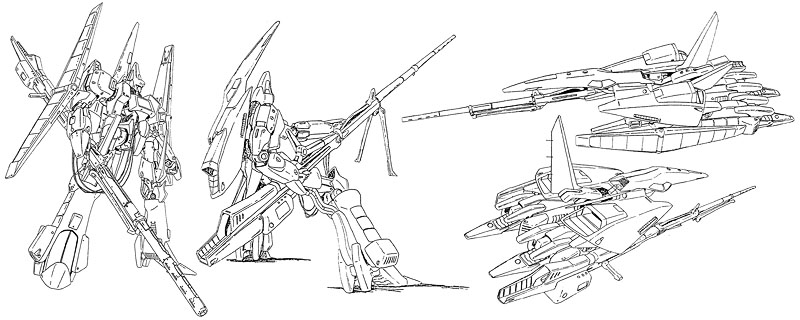
Super detail-up version: A version drawn to include even the details of the molding and the screws. There are no markings or warning signs on the heavy metal.
Land booster Plloler: The L-Gaim Mk-II transformed into its land booster form. If the buster launcher is removed, a maximum of eight power launchers can be installed. It can also dock with the L-Gaim and other heavy metals.
Buster launcher: A warship-class power launcher used by A-class heavy metals. It shoots fireballs using the highly compressed energy in its cartridges. This is the most powerful firearm of the Pentagna World, and only A-class heavy metals can endure its shock and recoil.
At the beginning of the proposal for this work, there was a message to the effect of "We want to restore the dreams of youngsters who have given up on life in a regimented society." It also said things like "Rather than mere mecha shows or robot shows, we should provide works and products filled with mechanical appeal" and "We'll pursue mechanical action that can be viscerally accepted."
Also distinctive was the fact that the target age group wasn't just the traditional younger viewers, but "everyone from grade- and middle-schoolers to high-school students." In other words, it was clearly expanded to the late teens. Based on all this, we can infer that it was being planned with particular emphasis on the mecha design and action, with the aim of creating a work with a new direction that could be widely accepted by the general public, especially older teenagers.
The main sponsor had shifted from Clover, which went bankrupt while Dunbine was airing, to Bandai. In addition to Hi-Metal toys which used steel plates for part of the body, Bandai's diverse product lineup also included plastic models and High Complete Models released in 1/144 scale. All of these were realistic products with movable joints and perfect reproduction of the onscreen gimmicks, reflecting the plan's goal of "mecha appeal."
Heavy Metal L-Gaim designer Mamoru Nagano is currently depicting a further developed and expanded version of the Pentagna World in The Five Star Stories, which will be familiar to readers of the monthly "Newtype" magazine.
The Five Star Stories can be traced back to the chronology and illustrations that were printed in full color at the beginning of the second Heavy Metal L-Gaim mook published by Kadokawa Shoten at the time of broadcast. Here, the L-Gaim Mk-I was called the Ahmesu Mk-I, the Mk-II was called the Grayon, and Daba became Comen Waller VI. In fact, the chronology published in this mook was the basis for the one included in each volume of the Five Star Stories comic.
I really like Mr. Mamoru Nagano's designs for L-Gaim. As someone whose view of mecha is based on rockets and aircraft, naturally I can't say I hate mecha. Anyway, in terms of a director's sense of aesthetics, there's no way that anyone who wants to become a movie director could dislike the overwhelming gorgeousness of streamlined things like Mamoru Nagano's creations! If you don't like Nagano design, then I think you're fundamentally unqualified to make movies.
The only important thing about L-Gaim is that it was definitely no mistake to appoint Mr. Nagano.
When it was on the air, I remember doing magazine interviews where I'd say things like "This is a touchstone for the anime world of ten years from now." That's because, as of Dunbine, I'd already done everything I could with a robot show. There was nothing more I could do as an individual, so I had no choice but to withdraw for a while and use that time to look for fresh talent. As a person of experience, I thought that might be the job I should be doing.
The work called L-Gaim is nothing more or less than that. When I said "Give L-Gaim's Pentagna World to Mr. Nagano," I didn't expect something like the current Five Star Stories, but I think it's fine that it's turned out like that.

Heavy metal comparison chart: A chart comparing the major A-class heavy metals, which also lists the production site and date of manufacture for each machine. The vast and detailed background setting created by designer Mamoru Nagano was also part of L-Gaim's appeal.
It seems that Mamoru Nagano had already begun his L-Gaim design work early in the summer of 1983, a year before the start of broadcast. Ideas such as random slates in the legs and double-jointed knees had apparently been established by this point. Among Mamoru Nagano's early design drawings was one showing a confrontation between the Bat-Shu and the L-Gaim (at that point named "Alon"). Titled "image from the beginning of the story," it resembles the opening scene of the first episode of The Five Star Stories.
Though most of the mecha setting was by Mamoru Nagano, some setting for the L-Gaim Mk-II and others was cleaned up by the Studio Bebow animator Tomonori Kogawa, who was in charge of the animation, and by Hiroyuki Kitazume, who was later responsible for the character design for the OVA version.
Created with unique lines, these heavy metals stood out at the time and are still remarkable. Even 15 years later, the toys and plastic models are frequently reissued and remain enduringly popular.

First from left: The earliest version was drawn in August 1983, about half a year before it aired. This robot was given the name "Alon."
Second from left: At the time, the featured giant robots were called "S.T. silhouette suits" rather than "heavy metals."
Third from left: Though the shape of the binder is different, and the overall image is very slender, this is fairly close to the final draft. This design was drawn in the summer of 1983.
Support mecha: As well as the land booster, there were also plans for a bike-type machine to support the main robot. Was this image inherited by the Mega-Rider from Gundam ZZ?
Other heavy metals: Naturally, many designs were also drawn for mecha aside from the main robot. The one printed here became the basis for the A-class heavy metal Bat-Shu. From the figure included for comparison, it seems it was imagined as a robot about ten meters tall.
Story • Following the last wishes of his geologist father, a boy named Yu Tagami travels to New Austral Island, a remote island in the South Pacific. In fact, New Austral Island conceals the secrets of an alien civilization. The island's very existence has been erased from the world through the machinations of the corporate giant Gail, which wants to monopolize these secrets. On the island, Yu meets the giant robot Gorg, a product of the alien civilization infused with the will of Zenon, an alien who died 30,000 years ago. Together with his father's disciple Dr. Wave and his sister Doris, as well as Gorg, Yu fights against the evil Gail and an international criminal gang.
Commentary • Mobile Suit Gundam character designer Yoshikazu Yasuhiko was responsible for the original story, direction, design, and so forth. This was a high-quality juvenile fiction that incorporated all the orthodox setting of an action-adventure drama for boys, such as an island shrouded in mystery, a huge evil organization, and intrepid youngsters. (1) It aired at 7:00 PM Thursdays on the TV Tokyo Network, running from April 5 to September 27, 1984. 26 episodes total.
Staff •
Cast •
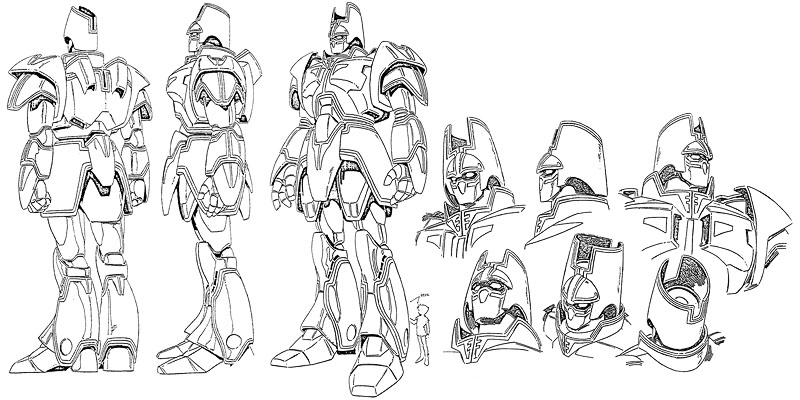
Gorg: The Gorg is designed with Yoshikazu Yasuhiko's characteristic rounded touch. Though it's a robot, it's also distinguished by the somehow humanoid impression it creates.
Head: The head has space for a human rider. Scenes in which the protagonist Yu rides in here are frequently depicted in the show.
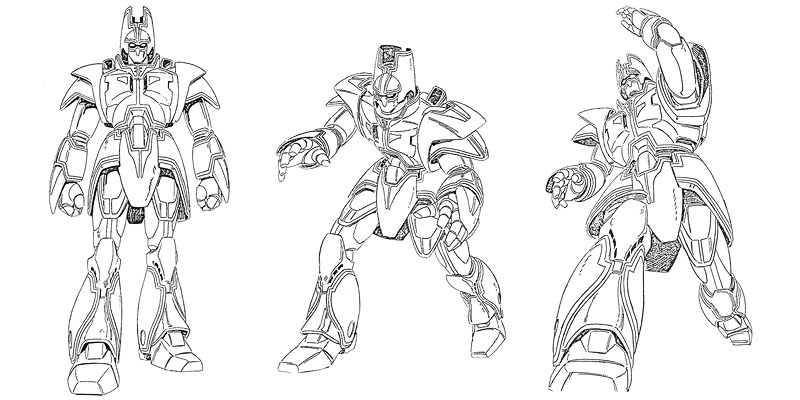
Pose collection: Thanks partly to Yoshikazu Yasuhiko's drawing ability, the Gorg's movements are extremely human-like.
Giant Gorg was Yoshikazu Yasuhiko's next attempt at directing after the 1983 theatrical anime Crusher Joe. Yasuhiko himself brought the plan to Nippon Sunrise (now Sunrise), and the title "Giant Gorg" came from the sound of Osamu Tezuka's robot manga Majin Garon. (2) As in Garon, the main robot doesn't transform or combine, and it carries no weapons. (As of episode 10, however, the Gorg is armed with a remodeled self-propelled artillery gun.)
While its production was reported in anime magazines at the time, it took a long time for the TV broadcast to begin, due to coordination with the sponsors who felt it lacked appeal as a toy. Among the staff was Mamoru Nagano, who was involved in guest mecha design and weapons research prior to his official debut.
In addition to various Gorg figures in different sizes, the main sponsor Takara also released deformed-type "Choro-Q" toys.
Because I created the plan, I believe I decided on the design of the Gorg itself pretty easily. I was particularly focused on the idea that the protagonist could ride in the head.
I've forgotten the origin of the title "Gorg," but it was probably inspired by Master Osamu Tezuka's Majin Garon. The Gorg's coloring also had the image of the movie Daimajin, and from the beginning I wanted to try for a dark monotone feeling.
I created Gorg with a great deal of fondness, but unfortunately it wasn't very popular... In that sense, it's a work with bittersweet associations. But it still has some very entertaining aspects. If you have the chance, I'd definitely encourage you to trust me and watch it.
All the early design for the main robot Gorg was handled by the original creator Yoshikazu Yasuhiko, and in addition to those shown here, there are other rough designs for the Gorg colored with markers. The concept of humans riding in the chest and head seems to have been in place from the beginning of the design process.
In the early designs for the Gorg, there's a strong toy-like nuance to things like the elbow and knee joint parts. However, the sponsors had no particular requests for design changes, and it's interesting that in the final draft the joints are changed to a design that's easier to move in animation.
Though this work aired in 1984, the proposal itself was written by Yoshikazu Yasuhiko at the end of 1982. Here, the story is set in the 1990s, and the Gorg's height is set to about eight meters, five meters shorter than the final version. It's also clearly specified that it will conclude in 26 episodes. It's noteworthy that the proposal says the Gorg is "a 180-degree change from the image of robots as weapons and tools," and it's defined as an entity capable of human-like interaction with the protagonist.

Left: This early design, with its protruding shoulders and the robotic structure of its ankles, has a generally rigid image. Note that the joint parts of the elbows and knees are also more robotic than in the final draft.
Right: Compared to the final draft, this early head design gives a somewhat sinister impression.
Story • The setting is the planet Arst in the Crescent Galaxy. Twelve years after the kingdom of Vorder was destroyed by the conquering King Mardoul, its surviving prince Jojo discovers the legendary iron giant Galient. Standing alongside the people of the White Valley who are resisting Mardoul, he uses the Galient to crush the iron giants dispatched by the enemy. With the involvement of an alien investigator who is pursuing Mardoul, the conflict soon expands into one that will shake the galaxy.
Commentary • Ryosuke Takahashi's third real robot work, following Votoms. Partly because the target age was lower than Votoms, the protagonist was established as a 12-year-old boy, and it became a heroic fantasy depicting adventure in another world reminiscent of medieval Europe. Though Mardoul was the villain, he stood out for the firm convictions with which he carried out his invasion, and Jojo's growth as he confronted Mardoul became the focus of the drama. It aired from 5:30 to 6:00 PM Fridays on the Nippon Television Network, running from October 5, 1984, to March 29, 1985. 25 episodes total.
Staff •
Cast •
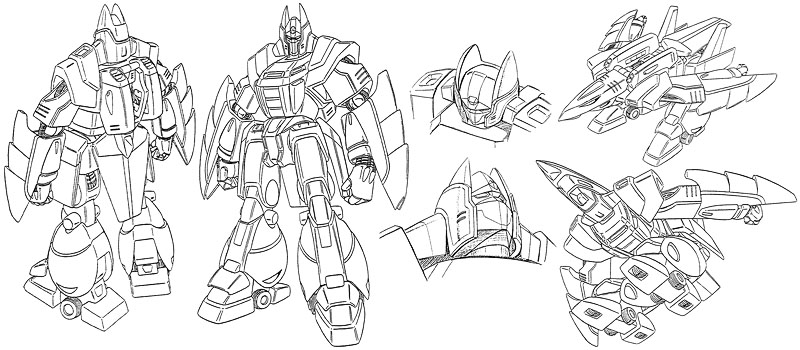
Galient: A humanoid weapon left behind by the ancient civilization of the planet Arst. Exhumed and operated by Jojo, this is the mightiest of the iron giants. It can change into a flight form and take to the air, and can also move on the ground with the roller dash in its feet.
Head: This is the first main mecha with a face to appear in Director Takahashi's real robot works.
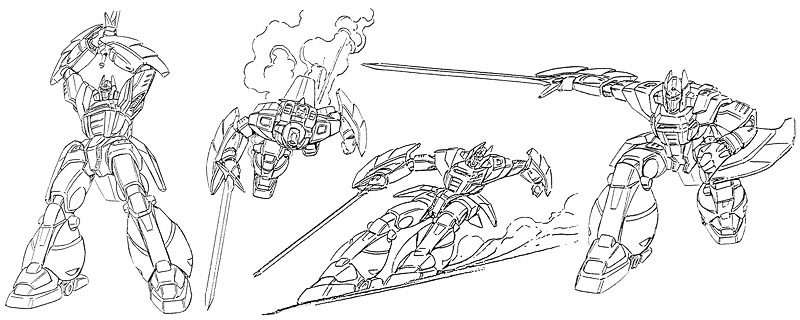
Sword action: The medieval era was a world of swordplay. Though these sword-wielding poses are familiar, they use samurai sword techniques as well as those of knights.
Roller dash: The roller dash mechanism that was so well-received in Votoms was also adopted in the Galient, apparently on the sponsor's wishes. The wheels may seem too small for its huge body, but the coolness of the action can't be denied.
Sword: The Galient Sword was known among the staff as the "jarajara sword." Stored inside the armor of the arm, this sword is made up of small blades, and can also be used as a whip.
Galient is a work with a "heroic fantasy" world that's unusual for a robot anime. In addition to the Galient, the robots known as iron giants which are established as excavated relics of an ancient civilization include the Mardoul army's Promaxis, Wingal, and Azolba. These enemy iron giants are unified by design lines reminiscent of medieval knights.
The product lineup was focused on alloy toys targeting younger age groups, but sales were poor, and in the second half of the program the Galient was changed to a separating and transforming version. Due to slow toy sales, the planned one-year broadcast run was shortened to half a year, but a video anime was later released with updated mecha and character setting.
On Galient, I was responsible only for the main mecha. Having it change into a flight form with a simple transformation was meant to make it easy to turn into a toy. It's my belief that being able to change completely with as few gimmicks as possible gives a toy greater commercial value. Besides, it doesn't take that long to come up with gimmicks. That sort of thing is naturally fun.
Later on, I turned the Galient's lower half into self-propelled artillery. I guess I thought something like that would suit the world of the story.
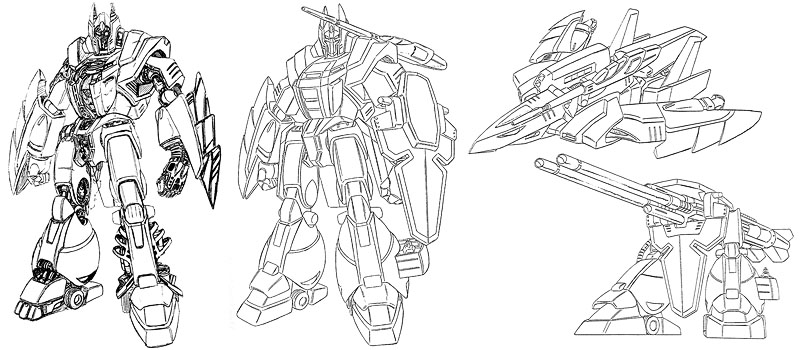
Galient undergoing reinforcement and remodeling: The damaged Galient undergoes repair and remodeling at Hilmocha's workshop in the White Valley. This rare illustration shows its internal structure.
Galient Heavy Arms Custom: The Galient, damaged by the flare shells of the Mardoul army's panzer ballista Monoccoto, is remodeled by the alien Hilmocha and newly equipped with a shield and a single beam cannon. This form is known as both the "Assault Galient" and the "Galient Heavy Arms Custom."
Panzer Falcon: The separated torso section can now fly on its own, dramatically increasing its flight performance.
Strike Vehicle: A combination of the Galient's lower body, its shield, and a four-barreled gun which can also be used as a hand cannon. Using its roller dash, it becomes a movable gun platform, or self-propelled artillery.
Story • The eccentric Dr. Kiwi uses an expanding metal of his own creation to upgrade the school-commuting robot Jumbow, which belongs to his young neighbor Michael. Aspiring to become a hero, Michael uses the enlarged Jumbow to confront the giant robots dispatched by space realtors who are trying to sell the Earth to aliens. He joins forces with Patty and Kamil, who have had the doctor upgrade their own school-commuting robots, and the trio soon have their hands full dealing with a series of strange incidents.
Commentary • Though the staff of Vifam stayed on to create this new work, the content was completely changed to gags and nonsense. Its unique style, which strongly reflected the tastes of character designer Toyo Ashida, was inherited by later works like Mashin Hero Wataru. Though this was much noted as the first voice performance by the rock singer Katsuhiko Nakagawa, he afterwards passed away at a young age. (3) It aired at 5:00 PM Saturdays (Fridays in the Tokyo region) on the Nagoya Broadcasting Network, running from October 6, 1984, to April 6, 1985 (one day earlier in the Tokyo region). 25 episodes total.
Staff •
Cast •
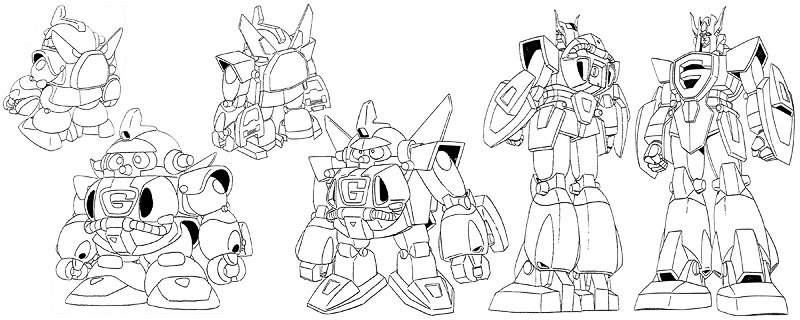
Jumbow: The exposed power pipes, a little like those of the Zaku, reflect the Okawara style. Though Jumbow can walk with his stubby legs, when commuting to school he uses the wheels in the soles of his feet to transport Michael with roller dash.
Jumbow Kurutt: Enlarged to a height of 6.1 meters thanks to expanding metal. Even at this stage, Jumbow can fight using his Banzai Sword. His overall form is distinctively angular.
Jumbow Galatt: Turning upside down as he transforms, Jumbow's height becomes 9.8 meters. Though controlled from within by Michael, Jumbow doesn't lose his personality, and is now a taciturn warrior. His design seems to be based on classic Sunrise hero robots.
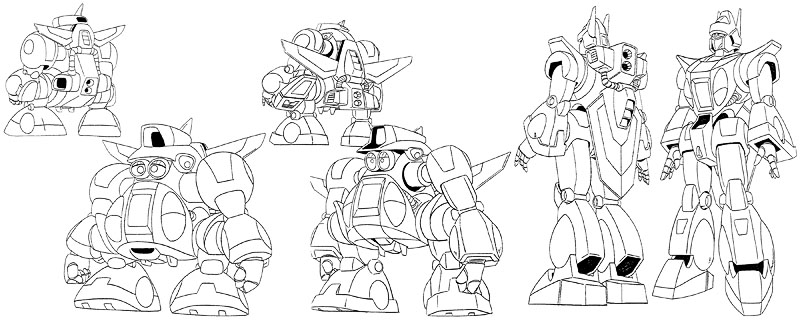
Patyge: Though they can't be seen in the illustration, wheels are installed in the soles of Patyge's feet, and like the other two robots she is capable of roller dash.
Patyge Kurutt: The enlarged Patyge is 5.5 meters tall. Though she is supposed to be girl who hates anything barbaric, she becomes a female warrior with a stern expression.
Patyge Galatt: Patyge transforms into a visibly feminine 9.0-meter Galatt. Despite her sleek proportions, she has few distinctive design features other than a striking pink body color.
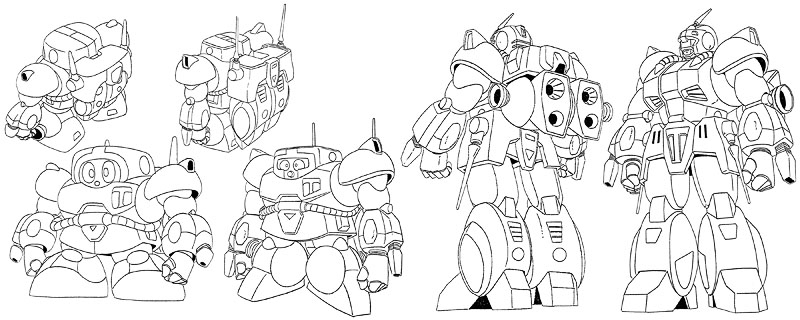
Kamige: Unlike the other two robots, Kamige has a backpack on his back. Perhaps the guns on his arms were added by Dr. Kiwi? He's certainly combat-oriented.
Kamige Kurutt: The enlarged Kamige takes on a square appearance, with a form resembling a walking tank. His overall height is 5.3 meters.
Kamige Galatt: Overall height 8.8 meters. The Kurutt feet on his backpack turn into nozzles, and perhaps because this was a followup to Vifam, he seems like a round vernian type.
Despite comical works such as Trider and Daioja, after the great success of Gundam, the impression that Sunrise works meant real robots was firmly established. Thus Galatt was planned as a nonsensical gag work that would defy this realistic trend. The plan at that point, titled "Morphing Superhero Robot Galatt," proclaimed a "new approach." (4) The fact that the main robot would combine Robocon-like elements and Gundam-like real robot elements was described as a selling point. (5) In other words, the work's dramatic structure, which shifted between gags and serious action, was echoed in a transformation from gag robot to serious robot.
Though this work was intended to "kill two birds with one stone," the extremely caricatured gags, represented by "Ashida characters" such as the Dosukoi Sisters and Moai Boy, weren't accepted by anyone other than anime fans. The show ended without ever managing to become a hit.
In terms of mecha, it introduced an innovative "handstand transformation" pattern, which as we all know has been inherited by recent tokusatsu series such as B-Robo Kabutack. With the technology of the time, however, it was difficult to make toys that transformed as in the anime, and those that were released were inadequate in terms of gimmicks.
During planning, the robots were named Jumbow, Step, and Hop, the source of which should be obvious. But aside from Jumbow, they were renamed after their owners to become Patyge and Kamige. It's interesting that the robots' functions are also specified, with Jumbow being a work assistant, Patyge a management assistant, and Kamige a domestic servant.
The leading role of Michael was performed by Mr. Katsuhiko Nakagawa. Though he was a singer, it seemed he wanted to try voice acting as well because he was fond of Triton of the Sea. So we gave him an audition, and we ultimately gave him the role because he was a breath of fresh air. Though it didn't happen due to issues with the record company, I really wanted to ask him to do the theme song, too.
The unique handstand transformation was Mr. Kunio OKawara's idea. I still talk with the character designer Mr. Toyo Ashida about how it was "premature" and "a little amateurish," but since aspects of this work later led to things like Mashin Hero Wataru, I think it was a good experience. (6)
I made mockups of all three robots from Galatt, but because the broadcast was decided so hastily, I remember I was frantically busy when I was doing it. I ran out of time and handed the robot designs over to someone from the planning staff, saying "You draw the faces." (laughs) Although I drew Jumbow's and Patyge's faces myself, I didn't design the faces of the three Galatts. (7) At the time, I'd done so many robot designs that I was running out of ideas for faces. (laughs) So I had to ask someone else to draw them for me.
For Jumbow and Kamige, it was important to decide things like which part became the waist when they transformed, so I did that myself. But the Galatts' hero faces were stowed away prior to transformation, so it didn't matter what their faces looked like. (laughs)
Nonetheless, I like thinking up transformations, so it was fun coming up with ideas for gimmicks. And I've always enjoyed designing cute little things like SD Gundams. But the part of the design process I liked best was no longer my responsibility. (laughs) So I really wish I could have designed those myself.
With Galatt, I had the idea of having them transform by turning upside down, but I did that because I thought there was no other option. (laughs) The sponsors didn't have many requests along the lines of "please do this part like this," so in that sense, I think those were good times.
On the other hand, back then people said that the quality of the Galatt toys wasn't so good. I think that's because there wasn't enough time to properly finalize the designs. I do have some regrets about that, and if they let me do something like Galatt now, I believe I could create something even better.

Size comparison chart: From the left are Kamil, Patty, and Michael. The school-commuting robots are shorter than the protagonist trio, but when they enlarge they instantly change to the sizes above.
Galatt was the first time (excluding guest mecha) that humanoid robots transformed, without combining, into different humanoid robots. The innovative idea of having the main robots transform by turning upside down, vividly showing the change from gag robot to serious robot, once again showed the world the talents of mecha designer Kunio Okawara. Through the many rough designs that were drawn at the time, we'll attempt to trace the process leading to the birth of the Galatts.

Rotating change: The basic concept of the robot design was already complete at the point when the idea of transforming via an upside-down rotation was illustrated.
Patyge type: This revision of the first rough design became the prototype for Patyge, which was similar to the final draft. It also has an eyeball that can show facial expressions.
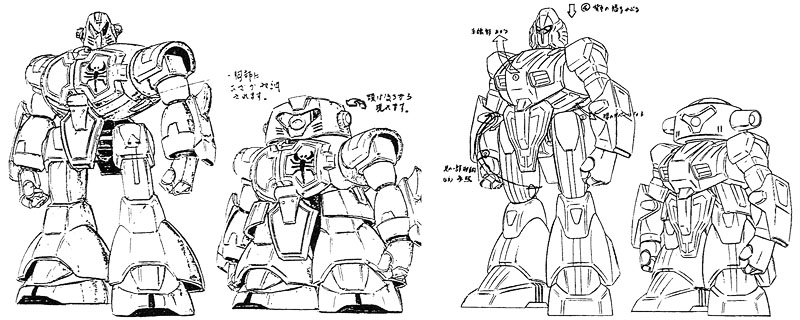
Head and body change: An early draft of a system that changes the height and head while maintaining a standing pose. This has a mono-eye.
When the serious robot's legs extend and contract, first the chest and abdomen cover flips up, and then the leg parts from the hip to the knee fold up for storage inside the chest.
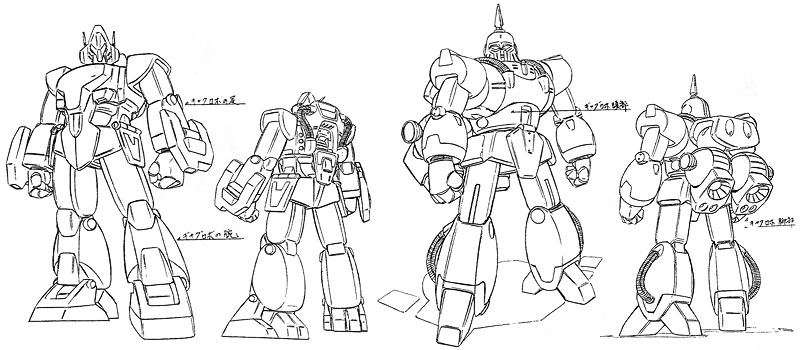
Reversible super transforming robot: The rotating change rough design was developed into two variation types. The A type, in which the arms turned into legs and the legs into arms, was an early version of Jumbow. The B type, which transformed by carrying the legs on the back as a backpack, seems to have been an early version of Kamige.
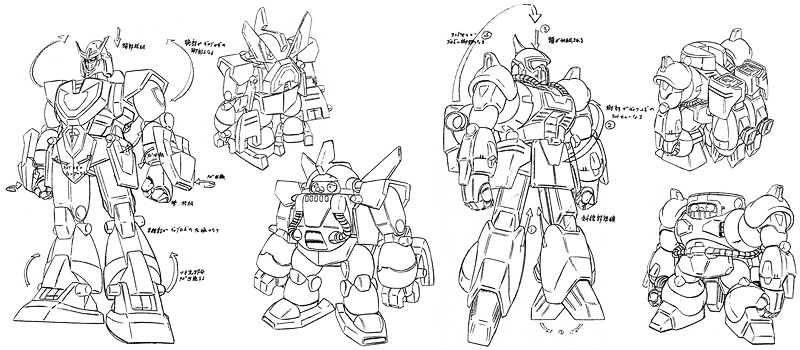
Jumbow type: The design for Jumbow Kurutt and Galatt was more or less completed by using the previous A type as a base, and adding the idea of turning the protectors into toes. The Galatt's head, which resembled the Zambot, was further changed to give its face an exposed nose and mouth.
Kamige type: With the addition of a head and body change system, the previous B type was developed into the prototype for Kamige Kurutt and Galatt. This didn't use the method of folding the legs into the chest, however. The Gallatt's face cover was later removed to reveal the mouth.
(1) The Japanese phrase 冒険活劇 (bōken katsugeki), literally "adventure action drama," is often translated as "swashbuckler" but that seems too suggestive of a historical period piece with lots of swordfighting. The English loanword "juvenile" (ジュブナイル) likewise refers to a genre of fiction that's now called "young adult."
(2) In Japanese, the "Giant" part of the title is written as 巨神 (kyojin) or "giant god," which resembles the 魔神 (majin) or "devil" of Tezuka's title.
(3) Nakagawa died in 1994, aged just 32.
(4) See note above regarding the Japanese term 変身 (henshin), translated here as "morphing."
(5) Robocon was a comedic tokusatu TV series from the 1970s, in which a robot lives with a human family.
(6) The Japanese phrase 早すぎた (hayasugita) literally means "too early." This could be interpreted as "ahead of its time," but it could also imply "rushed" or "done too quickly," which would align with Okawara's comments.
(7) Within the show, "Galatt" refers to the serious superheroic form of a given robot.
Mobile Suit Gundam is copyright © Sotsu • Sunrise. Everything else on this site, and all original text and pictures, are copyright Mark Simmons.